Cécile Paquet (Certified Organic)
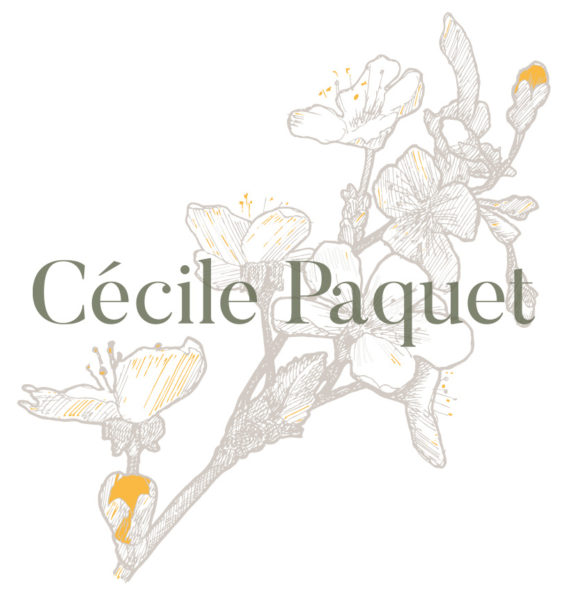
The Estate
Cécile Paquet grew up in a small village in southern Burgundy called Senozan. After more than 20 years working in plant nurseries, she decided to focus all her knowledge and expertise on the grapevine. Cécile works tirelessly in her micro domaine of 1.5 hectares to achieve the maximum expression of the terroir and craft wines of great quality. She works with the greatest of care, showing respect for the principles and rhythms of nature and the soil. The domaine is certified organic by Ecocert and practicing biodynamic.

Bourgogne Pinot Noir
Soil: Clay-limestone, muddy clay.
Grape Variety: 100% Pinot Noir
Viticulture: Certified organic and practicing biodynamic.
Vinification: The grapes are exclusively hand-picked into 15kg baskets and subjected to rigorous selection right in the vineyard and in the cellar. After this comes 9 days of maceration. The wine is neither fined nor filtered.
Aging: 14 months only in barrels.
Tasting Notes: Lovely ruby hue. Rich nose with aromas of red fruits (cherry, raspberry). Round on the palate with notes of licorice. Very complex, well-balanced and elegant Pinot Noir, typical from Burgundy.
Food Pairings: Can be appreciated as an aperitif, but also goes well with grilled red meats, chicken, creamy risotto, and cheeses.
Serving Temperature: 12-14°C

Mâcon-Villages
Location: The vines are planted in the commune of Igé in the Mâconnais region, in the southern part of Burgundy.
Soil: Clay-limestone, muddy clay
Exposure: Southeast
Grape Variety: 100% Chardonnay
Plant Density: 8,000 vines/ha
First Planting: 1987
Viticulture: Certified organic and practicing biodynamic
Vinification: Fermentation in temperature-controlled vats (cold) for 4 to 6 weeks. Use of natural yeast to allow the grape and the terroir to express themselves.
Aging: 100% in vats for 6 to 7 months to preserve the freshness of the Chardonnay. 100% malolactic.
Tasting Notes: This Mâcon-Villages has a pretty pale gold hue. Very perfumed nose of spring flowers and orchard fruits (pear, vineyard peach). The palate is rich, powerful, and well-structured. An easy-drinking wine.
Food Pairings: Ideal as an aperitif, but also delicious served with sushi, dim-sum, risotto, poultry, or with goat cheese.
Serving Temperature: 10-12°C

Saint-Véran
Location: Villages of Davayé and Prissé
Climate: Moderate
Soil: Clay-limestone, predominantly limestone
Exposure: South/southeast, north
Pruning Method: Guyot with short canopy
Grape Variety: 100% Chardonnay
Harvest: Manual harvest
Vinification: 100% malolactic fermentation.
Aging: 14 months in concrete tank.
Tasting Notes: This wine is suave and silky, offering aromas of citrus, pineapple and fresh almonds. The lively attack gives way to an ample wine with a long finish. Intense freshness with creamy texture.
Food Pairings: This Saint-Véran is a perfect accompaniment to scallops, seafood and fresh pasta, or can be enjoyed on its own, as an aperitif.
Serving Temperature: 12-13°C
Alcohol: 14%
Clos du Moulin Aux Moines (Biodynamic)
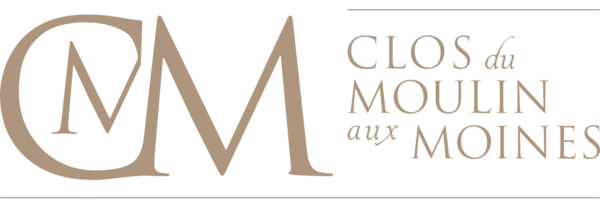
The Estate
A hotspot for the history of Burgundy, Moulin aux Moines is located in the heart of the Côte de Beaune, in the village of Auxey-Duresses. This mythical “clos” has been farmed and harvested since its plantation by the monks of the Abbey of Cluny, and then by those of the Abbey of Citeaux since 962, continuing for 6 centuries until present day. This unique area was chosen by the monks because of the environment’s qualities/features: a noble abode in the intersection of two valleys at the heart of the Cote de Beaune wine region, walled in by the Clos and penetrated by the Clous River which nourished the mill.
The year 2008 marked the revival of the domaine with the arrival of a new team. The idea was to restore the ancient values of its legendary wines, in the spirit of organic and biodynamic philosophy.
In 2009, after several years at domaine de Montille, Willy Roulendes joined Moulin aux Moines to manage the vineyards and the cellar, bringing his personal touch to produce vibrant terroir wines. With his arrival began the first year of conversion to organic certification. The winery has been certified Ecocert since 2012 and certified Demeter since 2021. The wines are also 100% vegan although not certified.
The domaine increased in size bit by bit over the years and now spans 15 hectares, extending from Pernand-Vergelesses to Corpeau, a village in the south of Puligny-Montrachet.
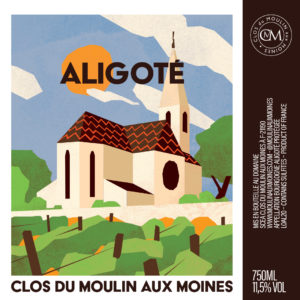
Aligoté
Location: The Aligoté is produced from 2 vineyards grown organically: Les Fas in Pommard (older vines planted at an altitude of 330m) and Clos de la Perrière in Corpeau (located south of Puligny-Montrachet, first planting in the late 1960’s. The grapes have a higher level of acidity here).
Soil: Limestone
Grape Variety: 100% Aligoté
Harvest: Manual
Vinification: The grapes are pressed slowly and then the juice is transferred to stainless steel tanks for gentle settling. Fermentation at a controlled temperature of 20-22°C with the use of indigenous yeasts. No sulfur added.
Aging: Steel tanks and a small portion in wooden barrels for 10 months.
Alcohol: 11.5%
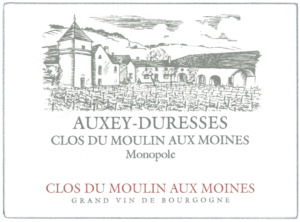
Auxey-Duresses Blanc Moulin aux Moines
Location: The Auxey-Duresses “Moulin aux Moines” vineyard is one of the Domaine’s four monopoles (vineyards exclusively owned by the Domaine). It is situated on the border of Meursault, and thus it shares a similar terroir.
Surface Area: 0.80 ha
First Planting: Early 2000s
Soil: Marl-limestone
Altitude: 298 meters above sea level
Grape Variety: Chardonnay
Exposure: North /northeast
Plant Density: 10,000 vines/ha
Harvest: By hand, towards September
Yield: 30 – 35 hl/ha
Aging: 12-15 months in oak barrels (0-5% new wood)
Bottles Produced: 1,800
Alcohol Content: 12.5%
Cellaring: 4-6 years
Tasting Notes: This wine possesses a superior aromatic complexity and is very expressive. The mouth has ripe fruits aromas, with nuts and fresh almond, complemented by notes of cloves, pepper, dry galangal (strong Malaysian herbal plant), vanilla, balsamic, sweet citrus fruits, mandarin, and gentian. This is a dense wine – harmonious and especially elegant.

Auxey-Duresses Rouge Moulin aux Moines Vieilles Vignes
Location: The Auxey-Duresses “Moulin aux Moines” vineyard is one of the Domaine’s 3 monopoles (vineyard exclusively owned by the Domaine. The “vielles vignes” section of the monopole was planted in the 1950’s in the upper part of the clos where the terroir is of a different composition, on a steeper canter, dryer and not to mention closer to the bedrock, supplying the wine with a deeper aromatic complexity pivotal to its character.
Surface Area: 0.90 ha
First Planting: 1950
Soil: Marl-limestone
Altitude: 298 meters above sea level
Grape Variety: Pinot Noir
Exposure: Northeast
Plant Density: 10,000 vines/ha
Harvest: By hand, towards September
Yield: 38 – 44 hl/ha
Aging: 16 – 18 months in barrel, no new wood
Bottles Produced: 4,000
Alcohol Content: 12.5- 13.5%
Cellaring: 10 years
Tasting Notes: The aromatic profile is very complex and extensive. The mouth is full of notes of ripe black fruit, cherry juice, and eau de vie. Also to be found are notes of roasted meats and almond that shape the frame of the tannic structure, providing more roundness and finesse than wines from the neighboring vineyard.
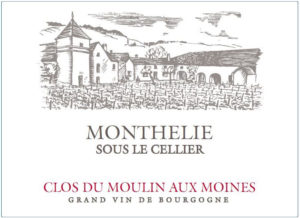
Monthélie Sous Le Cellier Blanc
Appellation: Monthélie
Location: this wine is produced from a plot located north of the Monthélie appellation. The slope is significant (330 meters above sea level), with an exposure to the west. The climate “Sous le Cellier” takes its name from its proximity to the cellar of the houses, since it is located at the exit of the village.
Size of Plot: 0.69 hectares
Grape Variety: 100% Chardonnay
Vines: Planted between 2003 and 2015
Plant Density: Around 10,000 vines/ha
Yields: Controlled at 42-48 hl/ha
Soil: Sandy / silty / limestone
Viticulture: Certified organic and biodynamic.
Harvest: Manually done with a rigorous sorting of the grapes.
Vinification: The direct pressing is long and progressive, so the musts oxidize slowly and naturally. Fermentation starts in 350 liter oak barrels, with the use of indigenous yeasts.
Aging: 10 months, no fining or filtration.
Tasting Notes: A delicious white with floral notes, with a nice roundness and a discreet woodiness!
Alcohol: 13%
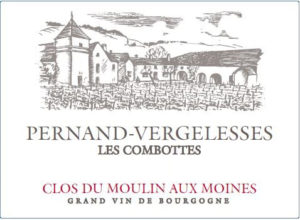
Pernand-Vergelesses Blanc Les Combottes
Appellation: Bourgogne Pernand-Vergelesses
Plot: The plot, whose vines are around 40 years old, is located on a hillside extending that of Corton Charlemagne.
Soil: White marl on clay-limestone soil
Grape Variety: 100% Chardonnay
Harvest: Manually done in September
Yield: 40 hl/ha
Viticulture: Certified organic and biodynamic
Vinification: The fermentation is long and gentle in steel tank.
Aging: In oak barrels for 12-18 months (15% new wood)
Alcohol: 13%
Cellaring: 4-7 years
Tasting Notes: This wine is mineral, fragrant, dry and balanced. With age, it develops notes of flinty stone and toasted almonds. it is the perfect accompaniment to seafood (especially shelfish).
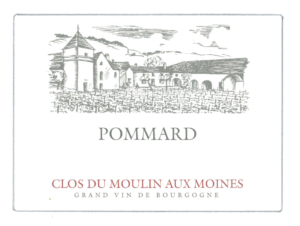
Pommard
Location: The Pommard Village is a blend of fruit from very compatible vineyards. The smallest plot is on “Croix Planet” vineyard, which produces fat and full wines. The plots of “Vaumuriens” and “Vignots” are old vines that give delicacy and structure to the final blend. The plot “La Vache”, which is a “climat” located on the hill-centre of the terroir, assures a rather mineral wine.
Surface Area: 1 ha
First Planting: 1947, 1983, 1988, 1999
Soil: Clay-limestone
Altitude: 270, 330, 353, 362 meters above sea level
Grape Variety: Pinot Noir
Exposure: East, north
Plant Density: 10,000 vines/ha
Harvest: By hand, towards September
Yield: 36 – 40 hl/ha
Aging: 12-15 months in oak barrels (5% new wood)
Bottles Produced: 4,150
Alcohol Content: 12.5%
Cellaring: 5-10 years
Tasting Notes: What stands out in the Pommard Village is it’s tannic structure with a particular rustic character typical of the terroir, whilst holding its elegance firmly intact with the touch of its silky interior. It sports a very pleasing acidity with juicy cherry and cocoa aromas, and will be serenity in a bottle after 2-3 years nesting in the cellar.
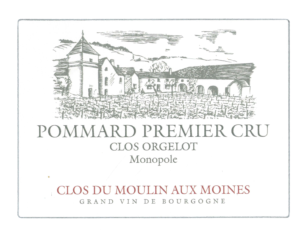
Pommard 1er Cru Clos Orgelot Monopole
Location: One of the Domaine’s emblematic cuvees; this wine is one of the monopoles (only producer of this wine). This plot of Pommard 1er Cru, slightly larger than 1 hectare, is said to be “among the most renowned areas of Pommard” (“The Bible”, Dr. Denis Morelot, 1831). This famous vineyard has an exceptional situation, located just above Pommard Epenots, between Les Pézerolles and Beaune 1er Cru “Clos des Mouches”. These old vines produce a very fine, structured, and elegant wine.
Surface Area: 1.1 ha
First Planting: 1921,1990,1993
Soil: Clay-limestone
Altitude: 310 meters above sea level
Grape Variety: Pinot Noir
Exposure: East
Plant Density: 10,000 vines/ha
Harvest: By hand, towards September
Yield: 25 – 30 hl/ha
Aging: 18-22 months in oak barrels (10-15% new wood)
Bottles Produced: 1,600
Alcohol Content: 13.5%
Cellaring: 10 years +
Tasting Notes: The “Clos Orgelot” vineyard develops aromas of ripened berries, acacia catechu, and exotic sandalwood. It has a rich structure that is curvaceous and velvety, and finishes with an enduring strength.
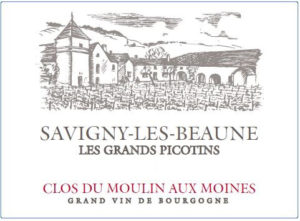
Savigny-les-Beaune Les Grands Picotins
Appellation: Savigny-les-Beaune
Soil: Clay limestone
Yield: 34-38 hl/ha
Grape Variety: 100% Pinot Noir
Viticulture: Certified organic and biodynamic
Harvest: Manually done in September; sorting on the vine as well as in the cellar.
Vinification: Depending on the temperature of the grapes, the musts can be lowered to 14 degrees Celsius in order to delay the start of fermentation and prolong the time of maceration. In order to bring out the elegance of the Pinot Noir, the pigeage is light and manually done. The focus is primarily placed on the daily pumping over. Vinification lasts between 15-25 days depending on the vintage.
Aging: The wine is aged in oak barrels (10-20% new wood) for 20-22 months. Bottling on the estate in the spring.
Cellaring: 2 to 5+ years
Tasting Notes: This wine displays a bouquet of ripe red fruit. On the palate, it is vibrant and pure.
Alcohol: 13.5%
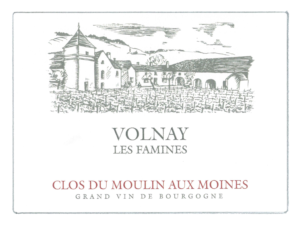
Volnay Les Famines
Soil: Clay-limestone
Yield: 34-38 hl/ha
Harvest: Manually done in September. Sorting in the vineyard as well as in the cellar. Grape harvest 70 to 90% depending on the vintage.
Vinification: Depending on the temperature of the grapes, the must can be lowered to 14°C in order to delay the start of fermentation and lengthen the maceration time. In order to work on the elegance of Pinot Noir, the punching down is light and manual. The main emphasis is on daily pumping over.
The vinification takes place over a long period, between 15 and 25 days depending on the vintage. Naturally, the musts rise in temperature in order to fix the color and the aromas. Once pressed, the wine is transferred, as much as possible by gravity, to old barrels and is not racked for the 12 months of aging. Bottling takes place in the spring.
Aging: In oak barrels for 20 to 22 months (10-20% new wood)
Alcohol Content: 13.5%
Acidity: 5.4 g/l
Cellaring: 5-10 years
Tasting Notes: An exceptional nose that reveals aromatic notes of wild red fruits. On the palate, it is an explosion of ripe black fruits. Delightful, lingering finish.
Comte Senard (Organic)
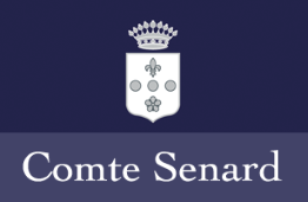
The Estate
In 1857, Jules Senard (great grandfather of the current owner) acquired the original Corton Clos Des Meix vineyard. Covering an area of just under 2.5 hectares, the vineyard has been a monopole ever since.
Over the years, the addition of prestigious appellations such as Corton Clos Du Roi, Corton Bressandes, and Corton Paulands has increased the prestige and excellent reputation of the Comte Senard estate. These acquisitions, carefully thought over and discussed among the family, have allowed them to offer an incomparable selection of the very best wines, spread over 9 hectares of prime vineyards.
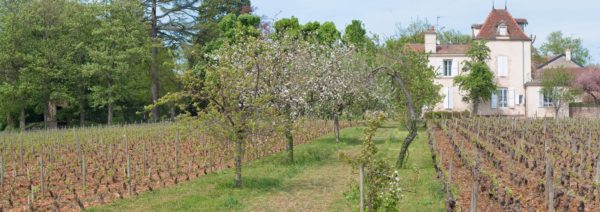
In 1971, Philippe Senard assumed management of the estate and personally took over the vinification process. His daughter Lorraine joined the family business in 2000, and succeeded him as manager in 2005 with an approach very much inspired by the previous generation’s respect of the land and desire to keep the Corton spirit alive. Lorraine’s first white wine vinification was the 2002 vintage, and 2005 for the red.
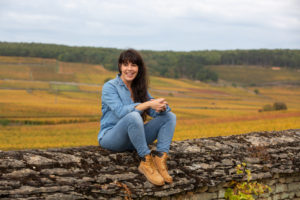
The estate has been organic since 2017, and will be certified in 2023. The Grand Cru vineyards of Corton Blanc and Corton Clos Des Meix are farmed biodynamically but are not certified.
Comte Senard Philosophy
The most important aspect of fine winemaking is the quality of the raw materials. The respect and great care that the winemakers bestow upon the vines ensures exceptional grape quality, which translates to rich and opulent wines.
Comte Senard has the goal of remaining respectful of the environment. With this objective in mind, they have opted for a sustainable-organic approach in the vineyard. They do not use herbicides or insecticides, they cultivate sustainable grass-covering, and utilize ploughing techniques throughout the estate.
Like her father Philippe before her, Lorraine Senard is an enthusiastic believer in initial cold-soaking and temperature control during the fermentation phase, and has been employing these methods since 2005. This approach not only enhances the color of the Corton and Aloxe-Corton, but also increases the aromatic complexity and taste of the wine – all qualities required for expressive wines with aging potential.

Aloxe-Corton Les Caillettes Pinot Gris
Overview: The only white Aloxe-Corton made from 100% Pinot Gris grape variety, called Pinot Beurot in Burgundy. The wine has subtle persistence, low acidity, and great finesse. Perfect as an aperitif, or paired with seafood.
Production Area: 0.23 hectares
Grape Variety: 100% Pinot Beurot
Average Age of the Vines: 70 years old (first planting 1913)
Average Yield: 600 bottles
Harvest: Following a thorough checking of the vine’s maturity, harvesting is carried out by hand. A first sorting is done manually by the harvesting team, followed by a second sorting when the grapes arrive at the winery with the help of a sorting table.
Vinification: Gentle and rapid pressing. Fermentation in 350-liter barrels.
Aging: 12 months in oak barrels (50% new wood)
Tasting Notes: On the palate, very round and fresh with notes of exotic fruits. Long on the finish. Very good cellaring potential.
Food Pairings: Foie gras, white fish, scallops
Cellaring: 1-7 years

Meursault
Overview: Its aromatic intensity, balance, and crisp freshness make this Chardonnay an amazing white to keep in your cellar.
Grape Variety: 100% Chardonnay
Harvest: Following a thorough checking of the vine’s maturity, harvesting is carried out by hand. A first sorting is done manually by the harvesting team, followed by a second sorting when the grapes arrive at the winery with the help of a sorting table.
Vinification: Fermentation takes place in oak barrels with the use of natural yeasts.
Aging: 15 months in 228-liter oak barrels.
Tasting Notes: Lemon, honey, and hazelnut notes are heightened by the vibrant acidity and roundness in this intense white.
Food Pairings: Foie gras, white fish, shellfish, creamy cheeses.
Cellaring: 1-5 years
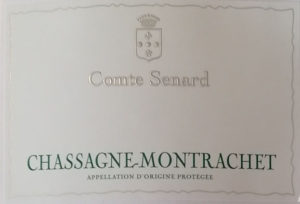
Chassagne-Montrachet Blanc
Grape Variety: Chardonnay
Vinification: Fermentation takes place in oak barrel using natural yeasts.
Aging: 16 months in 350 L oak barrels (50% new oak)
Tasting Notes: A beautiful nose which opens on exotic fruit notes, lemon, and toasted flavors. On the palate, it’s very fresh and delivers aromas of white fruits. Well balanced with a long aftertaste and a hint of lemon on the finish.
Food Pairings: Seafood, white fish, and chicken dishes.
Cellaring: 7 years from vintage.

Corton Blanc Grand Cru
Overview: 100% Chardonnay, this unique and rare wine combines the Clos Des Meix’s subtlety with the vigor of nearby Corton Charlemagne. This vineyard is farmed biodynamically.
Production Area: 0.46 hectares
Grape Variety: 100% Chardonnay
Average Age of the Vines: 25 years old
Average Yield: 1,800 bottles
Viticulture: The Grand Cru vineyard of Corton Blanc is farmed biodynamically but is not certified.
Harvest: Following a thorough checking of the vine’s maturity, harvesting is carried out by hand. A first sorting is done manually by the harvesting team, followed by a second sorting when the grapes arrive at the winery with the help of a sorting table.
Vinification: Gentle and rapid pressing. Fermentation takes place in oak barrels. SO2 added during bottling.
Aging: 18 months in oak barrels (40% new wood)
Tasting Notes: A silky and complex wine. It delivers aromas of exotic fruit, honey, and gingerbread. An unusual Chardonnay with a long finish.
Food Pairings: Ideal with strong cheeses.
Cellaring: 3-15 years
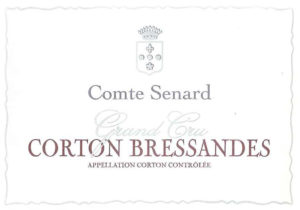
Corton Bressandes Grand Cru
Production Area: 0.64 hectares
Grape Variety: Pinot Noir
Average Age of the Vines: 25 years
Yield: 20,00 bottles
Vinification: 50% whole grapes. Natural yeast. Sorted at the winery. Cold pre fermented soaking for 1-3 days. Vinification for 2-3 weeks.
Aging: 18 months in oak barrels (60% new oak)
Cellaring: 5-20 years
Tasting Notes: Roundness and elegance are the prior characteristics of Corton Bressandes, the queen of the Corton Grands Crus. It is sweet, round, and complex.
Food Pairing: Red meats, poultry, and creamy cheeses such as Brie.

Corton Charlemagne Grand Cru
Overview: The most renowned of all the white Corton Grand Crus: elegance, finesse, richness, power and sensuality. These wines are full-bodied and rich and require aging to totally reveal all their complexity and delicateness.
Grape Variety: 100% Chardonnay
Average Yield: 600 bottles
Harvest: Following a thorough checking of the vine’s maturity, harvesting is carried out by hand. A first sorting is done manually by the harvesting team, followed by a second sorting when the grapes arrive at the winery with the help of a sorting table.
Vinification: Gentle and rapid pressing. Fermentation takes place in oak barrels. SO2 added during bottling.
Aging: 18 months in 350-liter oak barrels (50% new wood)
Tasting Notes: Elegance, finesse, richness, power. A truly great wine, well worthy of its appellation.
Food Pairings: Salmon, scallops, foie gras, sweetbreads.
Cellaring: 5-15 years

Bourgogne Blanc Ana
Overview: Named after the winemaker Lorraine’s daughter, Ana. This wine is like her: fresh and harmonious!
Production Area: 0.38 hectares
Annual Production: 3,000 bottles
Grape Variety: 100% Chardonnay
Average Age of the Vines: 10 years old
Vinification: Fermentation in oak barrels. SO2 added during bottling.
Aging: 12 months in 350 liter oak barrels (60% new oak).
Tasting Notes: Fresh and fruity wine enhanced by aromas of honey and white flowers. Elegant and well balanced on the finish. Very expressive while still young.
Food Pairings: Veal, fish, and shellfish.
Cellaring: 1 to 4 years

Bourgogne Rouge Auguste
Production Area: 0.88 hectares
Grape Variety: 100% Pinot Noir
Average Age of the Vines: 20 years old
Average Yield: 2,600 bottles
Harvest: Following a thorough checking of the vine’s maturity, harvesting is carried out by hand. A first sorting is done manually by the harvesting team, followed by a second sorting when the grapes arrive at the winery with the help of a sorting table.
Vinification: Cold pre-fermented soaking for 1-3 days. Vinification for 2-3 weeks. Natural yeast.
Aging: 14 months in oak barrels (50% new wood).
Tasting Notes: Named after the winemaker’s son, Auguste, this Bourgogne Rouge is expressive and complex on the nose, with red fruit aromas. A wonderful wine for everyday – fresh and fruity.
Food Pairings: Charcuterie and creamy cheeses.
Cellaring: 1-5 years

Aloxe-Corton Jules
Overview: This wine is blended from 5 different plots: Les Caillettes, Les Morais, Les Bruyères, Les Boutières, and les Nujots which are located on the lower slopes of the Corton hill. The Aloxe-Corton is the quintessence of all the Pinot Noir qualities and aromas and is considered among the best of the village appellations in the Côte de Beaune.
Production Area: 2.45 hectares
Grape Variety: 100% Pinot Noir
Average Age of the Vines: 30 years old
Average Yield: 3,500 bottles
Harvest: Following a thorough checking of the vine’s maturity, harvesting is carried out by hand. A first sorting is done manually by the harvesting team, followed by a second sorting when the grapes arrive at the winery with the help of a sorting table.
Vinification: 50% whole grapes. Cold, pre-fermented soaking for 1-3 days. Vinification for 2-3 weeks. Natural yeast.
Aging: 14 months in oak barrels (40% new wood).
Tasting Notes: Red berry aromas; ample and well-balanced.
Food Pairings: Poultry, aged cheeses
Cellaring: 3-7 years

Aloxe-Corton 1er Cru Les Valozières
Overview: The best location of all the Premier Crus, on the hillside of Corton, just below Les Bressandes. It has therefore inherited the same elegance and fruity aromas.
Production Area: 0.70 hectares
Grape Variety: 100% Pinot Noir
Average Age of the Vines: 25 years old
Average Yield: 2,400 bottles
Harvest: Following a thorough checking of the vine’s maturity, harvesting is carried out by hand. A first sorting is done manually by the harvesting team, followed by a second sorting when the grapes arrive at the winery with the help of a sorting table.
Vinification: 100% whole grapes. Cold, pre-fermented soaking for 1-3 days. Vinification for 2-3 weeks. Natural yeast.
Aging: 18 months in oak barrels (70% new wood).
Tasting Notes: Deep ruby color and a complex nose, with aromas of black and red fruits, licorice, and spice. Outstanding tannic presence and a long finish.
Food Pairings: Wild game, spicy foods, triple cream cheeses, and Comté.
Cellaring: 3-10 years

Corton Clos Des Meix Grand Cru Monopole
Overview: The estate’s “monopole” (exclusive production) is exposed full south and bordering on the Charlemagne area. The most pleasant of all the Cortons when young. This vineyard is farmed biodynamically.
Production Area: 1.64 hectares
Grape Variety: 100% Pinot Noir
Average Age of the Vines: 20 years old
Average Yield: 1,900 bottles
Viticulture: The Grand Cru vineyard of Corton Clos Des Meix is farmed biodynamically but is not certified.
Harvest: Following a thorough checking of the vine’s maturity, harvesting is carried out by hand. A first sorting is done manually by the harvesting team, followed by a second sorting when the grapes arrive at the winery with the help of a sorting table.
Vinification: 50% whole grapes. Cold, pre-fermented soaking for 1-3 days. Vinification for 2-3 weeks. Natural yeast.
Aging: 18 months in oak barrels (50% new wood).
Tasting Notes: Deep ruby color. A delicate wine, well-balanced with an impressive finish.
Food Pairings: Wild game, all kinds of cheeses.
Cellaring: 5-20 years
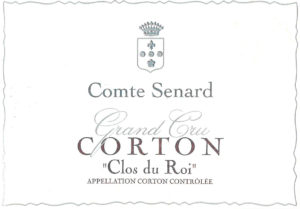
Corton Clos du Roi Grand Cru
Overview: The best known and most celebrated of all the Corton Grand Crus. A genuinely aristocratic wine. Powerful yet abundant in finesse.
Production Area: 0.64 hectares
Grape Variety: 100% Pinot Noir
Average Age of the Vines: 20 years old
Average Yield: 2,500 bottles
Harvest: Following a thorough checking of the vine’s maturity, harvesting is carried out by hand. A first sorting is done manually by the harvesting team, followed by a second sorting when the grapes arrive at the winery with the help of a sorting table.
Vinification: 40% whole grapes. Cold, pre-fermented soaking for 1-3 days. Vinification for 2-3 weeks. Natural yeast.
Aging: 18 months in oak barrels (40% new wood).
Tasting Notes: Bright ruby red color. Mature, supple, and velvety wine with red fruit aromas. Good cellaring potential.
Food Pairings: Wild game, grilled meats, poultry, light and creamy cheeses.
Cellaring: 5-20 years
Domaine Benoit Chevallier (Certified Organic)
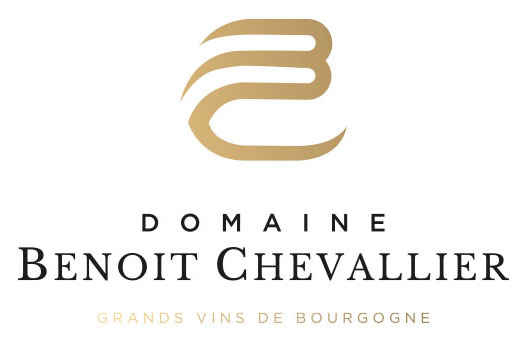
The Estate
Benoit is the 4th generation of Chevallier vignerons in Vosne-Romanée. He follows in the footsteps of his father, Maurice – former mayor of Vosne-Romanée, who had owned and tended 4 hectares since 1971. When Maurice retired in 2008, 90% of the family vineyards were rented out. However, Benoit managed the remaining 10% – aided by his sister Éloïse, a teacher – while simultaneously pursuing a promising career as an IT engineer at a local company after graduating from a Grande École in Paris in 2003. For 10 years, they produced tiny quantities from their 3 vineyards.
During his studies and at the beginning of his career, Benoit was fascinated with and always took full part in the harvest and vinification alongside his father. From 2008, he came to understand the significance of the vineyard tasks and the intricacies of micro-vinifications. In 2018, Benoit decided the time was ripe to return to Vosne-Romanée to become a full time vigneron and take over the entire Domaine. He recognized the need to be mindful of nature and immediately put his portion of the vineyards into organic conversion in 2018. Fortunately, the other 90% of the vines had been rented out to a local vigneron with outstanding experience of organic viticulture. They had been certified organic since 2012 and were in excellent health.
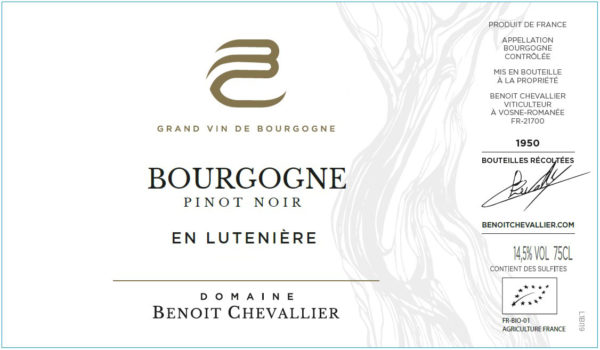
Bourgogne En Lutenière
Location: En Lutenière is located within Vosne-Romanée but just outside the line for full appellation rights.
Grape Variety: 100% Pinot Noir
Viticulture: Organic; all grapes are hand harvested with thorough sorting of the fruit in the vineyard.
Vinification: Indigenous yeast fermentation. 100% de-stalked. Minimal added Sulphur. 5-7 days cold soak followed by 15 day fermentation in wooden vats with +/- pump overs, depending on the vintage. One or two punch downs at the end of the alcoholic fermentation.
Aging: 13 months in 2-3 year old casks
Tasting Notes: Ruby color, with a bouquet of ripe raspberries and zingy redcurrants. Supple and concentrated on the palate with silky tannins. Juicy fruit on the finish.
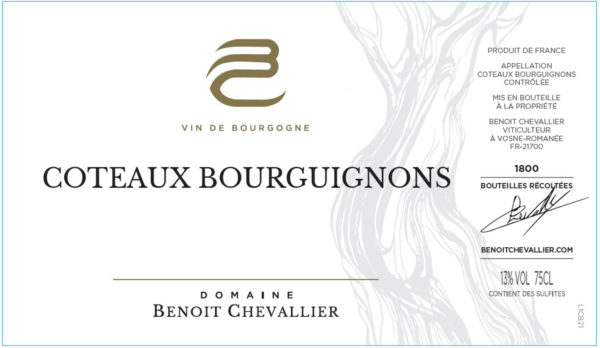
Coteaux Bourguignons
Winemaker Notes: “My most complicated plots to work, due to the nature of the soil. Either too hard to plow, or too wet to pass the machinery. The right moment often takes place over a few hours. It’s still a hassle, but worth it. This wine is for me a “friend” wine, for sharing and conviviality.”
Township: Vosne-Romanée
Vineyard Plots: Aux Glapigny Poncey (0.30 hectares, 100% Pinot Noir), Les Chassagnes Corvées Aux Prêtres (0.46 hectares, 75% Pinot Noir), Aux Rouges Champs (0.15 hectares, 100% Pinot Noir)
Soil: Deep red clay
Grape Variety: 87% Pinot Noir
Age of the Vines: 70 years old
Average Yield: 37 hl/ha
Harvest: Manually done, with sorting on the vine.
Vinification: Fermentation with native yeast, no extraction.
Aging: Aged for 12 months.
Tasting Notes: Made from older, low-yielding vines, this wine is characterized by a high phenolic concentration. Dark red color, tending to black. The nose presents floral and black fruit aromas. Beautiful energy on the palate, marked on the attack by powerful aromas of black fruits (blackberries, blackcurrant). On the finish we find robust tannins balanced by a nice acidity.
Food Pairings: Ideal wine to accompany fondue cheeses such as raclette in winter, or with grilled foods in summer.
Cellaring: Keep for 2-5 years.
Serving Temperature: 16-17°C
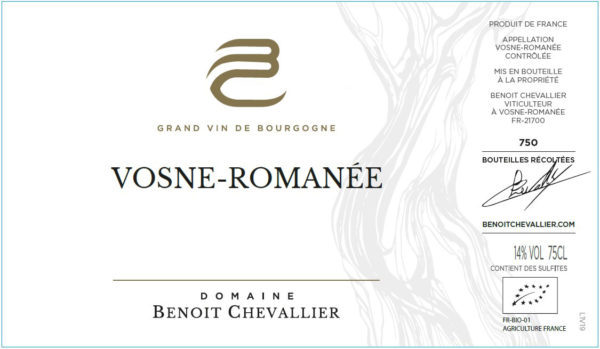
Vosne-Romanée
Vines: 60-year-old vines from the following plots: Aux Ravioles (0.28 ha), Aux Jacquines (0.07 ha), La Colombières (0.23 ha), Aux Ormes (0.09 ha), La Croix Blanche (0.10 hectares)
Grape Variety: 100% Pinot Noir
Viticulture: Organic; all grapes are hand harvested with thorough sorting of the fruit in the vineyard.
Vinification: Indigenous yeast fermentation. 100% de-stalked. Minimal added Sulphur. 5-7 days cold soak followed by 15 day fermentation in wooden vats with +/- pump overs, depending on the vintage. One or two punch downs at the end of the alcoholic fermentation.
Average Yield: 42hl/ha
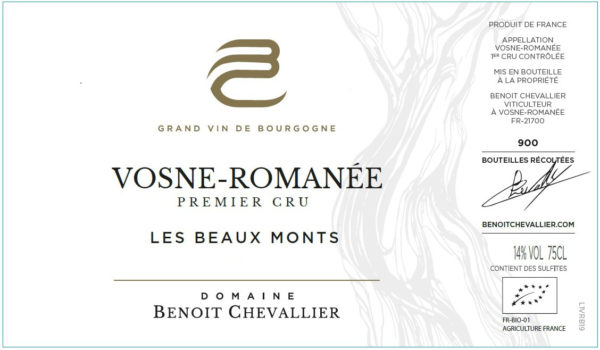
Vosne-Romanée 1er Cru Les Beaux Monts
Location: Les Beaux Monts is situated between Vosne-Romanée 1er Cru Les Suchots east, Aux Brulees south, La Combe Brulees, and Les Haits Beaux Monts west. Flagey-Echezeaux 1er Cru Les Beaux Monts Bas and Les Beaux Monts Hauts are to the north.
Grape Variety: 100% Pinot Noir
Viticulture: Organic; all grapes are hand harvested with thorough sorting of the fruit in the vineyard.
Vinification: Indigenous yeast fermentation. 100% de-stalked. Minimal added Sulphur. 5-7 days cold soak followed by 15 day fermentation in wooden vats with +/- pump overs, depending on the vintage. One or two punch downs at the end of the alcoholic fermentation.
Tasting Notes: Hedonistic with wild blueberry notes. Concentrated, suave texture but fine freshness; precision and energy.
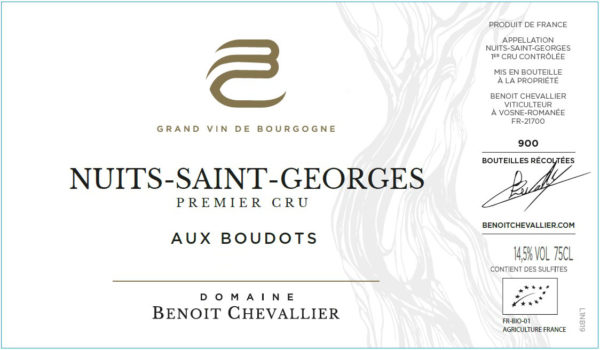
Nuits-Saint-Georges 1er Cru Aux Boudots
Location: The Aux Boudots plot is in the northernmost part of the Premier Cru Nuits-Saint-Georges appellation.
Soil: Gravel, limestone, clay
Grape Variety: 100% Pinot Noir
Viticulture: Organic; all grapes are hand harvested with thorough sorting of the fruit in the vineyard.
Vinification: Indigenous yeast fermentation. 100% de-stalked. Minimal added Sulphur. 5-7 days cold soak followed by 15 day fermentation in wooden vats with +/- pump overs, depending on the vintage. One or two punch downs at the end of the alcoholic fermentation.
Tasting Notes: Notes of licorice, violets, and wild blueberry. Silk on velvet texture, with subtle vanilla bean overtones, and a long, wild blueberry sorbet finish.

Nuits-Saint-Georges 1er Cru Aux Damodes
Winemaker Notes: “Due to its 35% slope, these vines are always worked with great apprehension and humility. Better to be in good shape to move up the ranks. This plot offers a magnificent panorama of the village of Vosne-Romanée, and sometimes a remarkable view of Mont Blanc. Due to the proximity of the vines to the climats of Vosne-Romanée, the wines produced are very delicate of the Nuits Saint Georges appellation.”
Soil: Clays and sand, combined with limestone silt on the rock surface.
Grape Variety: 100% Pinot Noir
Age of the Vines: 50 years old
Vineyard Plots: Aux Damodes (0.28 hectares)
Average Yield: 40 hl/ha
Harvest: Manually done, with sorting on the vine.
Vinification: Cold pre-fermentation maceration; fermentation with indigenous yeast; little extraction.
Aging: 18 months (50% new barrels)
Tasting Notes: Clear and brilliant color, ruby to intense red. Fresh aromas of tangy fruits. Its moderate structure gives flexibility and lightness throughout the tasting. Its delicate tannins combine with the aromatics and give this wine a harmonious depth.
Food Pairings: This wine goes well with both white meats such as guinea fowl, stuffed free-range chicken, or suckling pig, as well as juicy red meat such as a rare prime rib or rack of pork. Establishing itself after a few years, it will accompany stronger soft cow’s cheeses such as Époisses or Soumaintrain.
Cellaring: Keep for 6 to 15 years
Serving Temperature: 16-17°C
Domaine Bertrand et Axelle Machard de Gramont (Organic)

The Estate
Bertrand Machard de Gramont created the estate in 1984 after having worked in Chambolle Musigny at Comte de Vogue. In 2001, the production area was expanded to 6 hectares thanks to the spectacular replanting on the terraces of the “Vallerots” plot, on virgin soil which had been partly abandoned since Phylloxera. Bertrand’s daughter, Axelle Machard de Gramont, is the current owner and winemaker of the domaine. As the granddaughter of a Dufouleur, Axelle has winemaking in her blood, however when she was 20, she took what became a 15-year hiatus to Paris where she became a real city girl. Living there made her aware of ecology and also gave her the opportunity to taste organic wines which were just becoming popular in Paris wine bars at the time. She returned to the domaine in 2004 to join her father in the family business. It was due to her – and despite concern from her father – that the domaine converted to organic production, and was certified in 2014. Today she runs the domaine and she ferments all her wines using natural yeast. Where new oak is used, it is done so sparingly, and all the wine is unfined and unfiltered with limited amounts of sulfur. Very minimal intervention is the goal.
Harvest
Harvest time is generally in the second part of September. The grapes are hand picked by a team of 20 people and gathered into 30 kilogram boxes. Generally, the Hauts-Prûliers plot is harvested first as these grapes always mature the earliest, due to the south-eastern exposure and protection by a high wall. The last vineyards to be harvested are Les Vallerots and Les Terrasses des Vallerots, as they are planted at one of the highest points in the Nuits-Saint-Georges appellation.
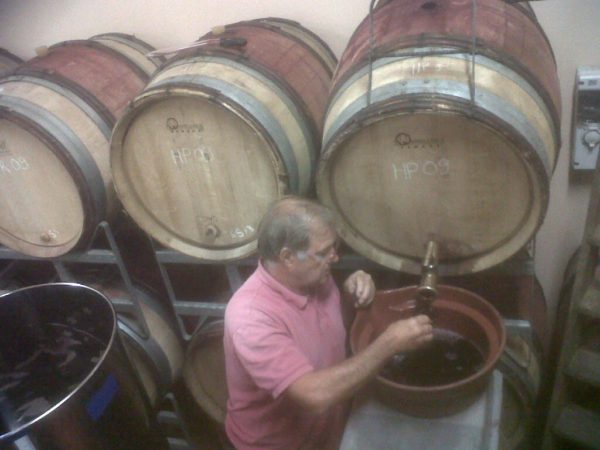
Vinification
The harvest is 100% destemmed, then the grape bunches are placed in large wooden tanks. The juice is put in a cooling unit to lower the temperature to 6-8 °C. The alcoholic fermentation period lasts around 2 weeks; punching the cap and pumping-over are both carried out. Then devatting and pressing are done before settling of the juice in a sedimentation tank.
Aging
The wine is put into 228 liter oak barrels; most of them are second hand barrels (to avoid too much woody taste). There is no racking after the malolactic fermentation. After 18-20 months, each barrel is racked and put in a tank for blending. Sulfur is added before bottling on premises; no fining or filtration.

Bourgogne Aligoté Le Chêne du Court
Grape Varieties: 100% Aligoté
Harvest: Handpicked; the bunches of grapes are picked up in a picking bucket then gathered in grape boxes of 30 kgs. Harvesters sort spoiled bunches.
Vinification: The whole bunches are immediately put in a pneumatic press after arriving at the winery. The juice goes in a sedimentation tank for 24 hours, then it is carefully racked. Half of the juice goes in second hand barrels, the other half in a stainless-steel tank for fermentation and aging. After one year, the wine from the barrels is racked to be blended and then put into the tank also. The bottling is made without fining or filtration, and only a little SO2 is added.
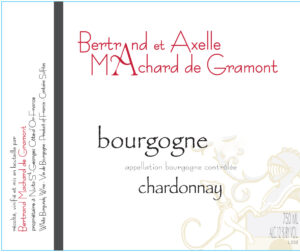
Bourgogne Chardonnay
Location: Produced in the Hautes-Côtes de Nuits, below Gramont’s Aligoté vineyard.
Production Area: 0.15 hectares
Grape Variety: Chardonnay
Average Age of the Vines: Bertrand Gramont planted the vines 20 years ago.
Annual Production: About 1,000 bottles a year.

Bourgogne Les Grands Chaillots
Location: A single 0.5-hectare parcel of vines planted in 1986, situated in the Nuits-Saint-Georges appellation below the road and Chaillots. This is not village but a regional wine.
Soil: Great depth with some clay, and iron-rich stones which aid drainage.
Grape Variety: 100% Pinot Noir
Tasting Notes: Luscious dark fruit on the nose, medium intensity and expressive with aromatic notes of black cherry. Rich red and black fruit notes on the palate. Well balanced, with soft tannins and a light acidity.

Nuits-Saint-Georges Les Terrasses des Vallerots
Production Area: 2 hectares
First Planting: In 1984, by Bertrand Machard de Gramont. This plot had sat unplanted and untreated since the Phylloxera crisis in the 19th century, resulting in wines that reflect the purity of the terroir.
Grape Varietal: 100% Pinot Noir from 15 year-old vines
Soil: Clay limestone
Harvest: The fruit is hand-harvested and sorted.
Vinification: 100% destemmed. 2 weeks of fermentation, followed by aging in 228-liter used oak barrels for 18-20 months. Unfined, unfiltered, and minimal sulfur added.
Tasting Notes: This is a wine of fine aromatic purity and fresh, mineral character.

Nuits-Saint-Georges Les Vallerots
Production: Organic
Grape Varieties: 100% Pinot Noir
Average Age of the Vines: 30-year-old vines
Location: This wine is produced from vines on a half-hectare that sit just above “Les Terrasses.”
Harvest: Hand-harvested and sorted. 100% destemmed.
Vinification: 2 weeks of fermentation then
Aging: 228-liter used oak barrels for 18 – 20 months. Bottled unfined, unfiltered, and minimal SO2 added.

Nuits-Saint-Georges Aux Allots
Location: Situated at the base of the hill, close to Vosne-Romanée.
Grape Varietal: 100% Pinot Noir from very old 80-100 year old vines.
Soil: Deep layers of clay and limestone.
Harvest: The fruit is hand-harvested and sorted.
Vinification: 100% destemmed. 2 weeks of fermentation, followed by aging in 228-liter used oak barrels for 18-20 months. Unfined, unfiltered, and minimal sulfur added.
Tasting Notes: This wine is fleshy and full and with a long, beautiful finish.

Nuits-Saint-Georges Les Hauts-Pruliers
Production: Organic
Grape Varieties: 100% Pinot Noir
Average Age of the Vines: 50-year-old vines
Location: This parcel sits just uphill from 1er Cru “Les Pruliers”
Soil: Thin layer of top soil, then pure rock terroir.
Harvest: Fruit is hand-harvested and sorted. 100% destemmed.
Vinification: 2 weeks of fermentation.
Aging: 228-liter used oak barrels for 18 – 20 months. Bottled unfined, unfiltered, and minimal SO2 added.

Vosne-Romanée
Overview: From 3 different Vosne holdings acquired in 2002 by Axelle’s family: 16% Maizières Basses, 48% Champs Goudins, 36% Aux Ormes.
Average Age of the Vines: 35 – 40 years old
First Planting: 1960s
Grape Varieties: 100% Pinot Noir
Vinification: Fruit is hand-harvested and sorted. 100% destemmed. 2 weeks of fermentation then aging in 228-liter used oak barrels for 18 – 20 months. Bottled unfined, unfiltered, and minimal SO2 added.
Tasting Notes: Deep purple to the rim. This is a vibrant wine, with a fresh, lively nose of juicy blackcurrant. On the palate, lovely velvety black fruit notes. Supple, lightly spiced, rich and deliciously approachable, with a long, fresh finish.

Vosne-Romanée Les Barreaux
Overview: This plot was acquired in 2002 by Axelle’s family. Les Barreaux is located at the top of the slope, surrounded by 3 premier crus and 1 grand cru – Cros Parentoux, Les Petits Monts, Aux Brulées and Richebourg.
Average Age of the Vines: 35 – 40 years old
First Planting: 1960s
Grape Varieties: 100% Pinot Noir
Vinification: Fruit is hand-harvested and sorted. 100% destemmed. 2 weeks of fermentation then aging in 228-liter used oak barrels for 18 – 20 months. Bottled unfined, unfiltered, and minimal SO2 added.
Tasting Notes: Deep purple to the rim, vibrant, with a fresh, lively nose of blackcurrant, juicy, crunchy and fresh. On the palate lovely velvety black fruits, supple, lightly spiced, rich and deliciously approachable with a long, fresh finish.
Domaine Chevalier Père et Fils
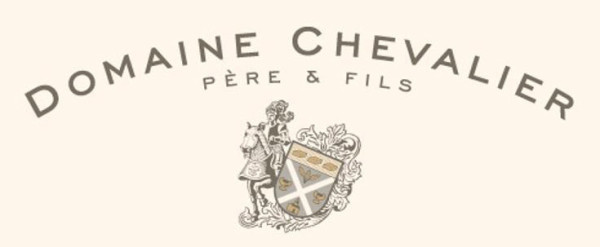
The Estate
Marcelle Dubois, along with his daughter and son-in-law, Emile Chevalier, inherited the estate just after WWI. Conscientious and meticulous, Emile Chevalier spent years of hard work perfecting the quality of the vines after the difficult years of the phylloxera crisis. His son, Georges, took over management after Emile and began to enlarge the estate and increase the prestige of Domaine Chevalier, beginning with the planting of 3 hectares of vines in Gamay.
Georges Chevalier learned quickly, not only because he loved this work, but because of his serious dedication to producing remarkable wines. In 1959, he decided to bottle all the harvests, the result being that since 1969, all wines sold to his customers were sold in bottles bottled on the estate. In 1975, Georges’ son Claude joined the family business, and continued to expand the estate by adding a further 11 hectares.
Since 1994, Claude, with the influence of his father, has concentrated solely on vinification of Estate wines. In 1998, he decided to change certain working methods in the vineyard, as well as the vinification process—new barrel selection, fermenting time, maturing time in barrels, filtration, etc.
Today, the estate is run by Claude Chevalier’s three daughters who represent the 5th generation of wine-growers in the Chevalier family: Chloé has been managing winegrowing and winemaking since 2008 after obtaining her Viticulture-Oenology BTS in Beaune; Julie, who has a diploma from the l’école de Commerce de Reims, directs sales and administration; and Anaïs, who joined her sisters in the business in 2012, handles accounting and welcoming customers to the winery.
The Location
Two hamlets share this Domaine of 266 hectares: Ladoix, which takes its name from the old French name “La Douix” (The Source) and Buisson, recognized since 1305 and former property of the Hospices de Beaune.
The southeastern exposure as well as its unique and exceptional position—at the northern tip of the Côte de Beaune and the edge of the Côte de Nuits—offers a nice hierarchy of AOC wines, which few villages can approach, with its AOC Burgundy red and white, AOC Villages red and white (120 ha), AOC Villages Premier Cru red and white (35 ha), and finally the AOC Grands Crus (29 ha) with the famous Corton red and Corton Charlemagne white.
It is thanks to the hard work of the winemakers and the quality of the wines they produce (very balanced and uniquely structured reds and whites with complex characteristics and superior aging potential) that Ladoix has gained notoriety, which it richly deserves.
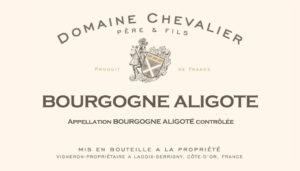
Bourgogne Aligoté
Location: Regional appellation of Burgundy. The appellation Bourgogne Aligoté is restricted to white wines grown from the Aligoté grape
Production Area: 0.82 hectares
Average Age of the Vines: 30 years old
Grape Variety: 100% Aligoté
Vinification: Racking of the must for about 24 hours. The wine is cooled before alcoholic fermentation takes place in vats for a period of 11 months (one part in oaks barrels when available). Fining and light filtration before bottling.
Annual Production: About 6,000 bottles
Tasting Notes: The color is a brilliant gold. The bouquet is vibrant with honeyed aromas of vanilla and hazelnut. The attack is supple and round on the palate with notes of lemon and vanilla.
Serving Temperature: 11-12°C
Food Pairings: Excellent as a pre-dinner aperitif, or mixed with blackcurrant liqueur to become “Kir”. Matches well with grilled fish, oysters, puff pastries, escargot with butter and garlic, and Jambon Persillé, a Burgundian specialty.
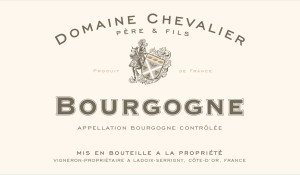
Bourgogne Blanc
Location: Regional appellation; the vineyards are situated in the village of Ladoix Serrigny
Exposition: South and east
Soil: Clay and limestone
Production Area: 0.2 hectares
Average Age of the Vines: 40 years old
Grape Variety: 100% Chardonnay
Annual Production: About 1,400 bottles
Vinification: The wine is vinified in thermo-regulated stainless-steel tanks (16-18°C) and in oak barrels renewed by third every year.
Aging: In oak barrels for 6-7 months with batonnages of the lees
Tasting Notes: Transparent golden color, bright and clear with green reflections. The nose is discreet, fine, fresh, and elegant, with soft and subtle aromas. The wine is fatty on the palate at the start with a good balance between freshness and roundness. Notes of honey and white flowers, with a hint of smokiness. Long finish with a surprising punch of prunelle (plum liqueur).
Serving Suggestions: Excellent as an aperitif or paired with fish or poultry.
Alcohol Content: 13%
Serving Temperature: 10-12°C

Bourgogne Rouge
Location: Regional appellation; from parcels based in the village of Ladoix
Production Area: 0.34 hectares
Grape Variety: 100% Pinot Noir
Annual Production: 3,000 bottles
Vinification: Traditional vinification in vats for 10 days with temperature control. Maturation takes place in oak barrels for 10 months. Bottling in September before or after harvest.
Tasting Notes: This wine has an elegant and refined character as well as a light and fluid structure in the mouth. It is richly colored-crimson when young, and shading towards dark ruby with age. The bouquet has aromas of strawberry, cherry, cassis, and blueberry which evolve into cooked prune, pepper, and earthy notes.
Serving Temperature: 12 to 14° C
Food Pairings: Salads, meat or poultry tarts, and Pot-au-feu (French beef stew)
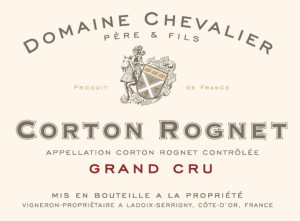
Corton-Rognet Grand Cru
Location: Grand Cru appellation of the Côte de Beaune district. The parcel from which the grapes are harvested, called “Rognet et Corton,” is situated in the village of Ladoix Serrigny
Soil: Chalk and clay
Production Area: 1.15 hectares
Grape Variety: 100% Pinot Noir
Average Age of Vines: 35 years old
Annual Production: 4,500 bottles
Vinification: Traditional vinification; alcoholic fermentation takes place in temperature controlled vats
Aging: Maturation in oak barrels (50% new wood) for 12 months
Tasting Notes: Deep plum color, with a nose that is characterized by notes of black fruit such as cassis and blueberry. The mouth is ample and generous.
Serving Temperature: 14-16°C
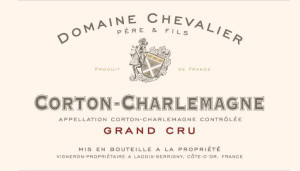
Corton-Charlemagne Grand Cru
Location: Grand Cru appellation located on the hill of Corton, with a wide sunny exposure
Soil: Chalk and clay
Production Area: 0.36 hectares
Grape Variety: 100% Chardonnay
Average Age of Vines: 2 parcels: 10-36 years old
Annual Production: 1,800 bottles
Vinification: Débourbage for 24 hours. The wine is cooled before alcoholic fermentation takes place in oak barrels for a period of 11 months (50% new wood). Fining and light filtration before bottling.
Tasting Notes: Lightly wooded but without excess, excellent body and firmness of constitution thanks to the terroir; more broad on the palate than long lasting; savory notes.
Serving Temperature: Same temperature as the wine cellar
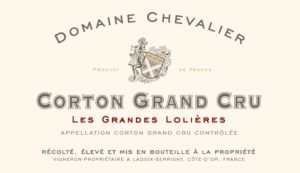
Corton Grand Cru Les Grandes Lolières
Location: Corton “Les Grandes Lolières” is located in the commune of Ladoix. Slightly lower on the hillside than Le Rognet and Corton lieu-dits. Exposed to the south, these vines enjoy the best sunshine.
Production Area: 0.25 hectares
Soil: Clay-limestone
Grape Variety: Pinot Noir
Average Age of the Vines: 50 years
Production: Around 1,000 bottles
Vinification: In vat for 10 days with temperature control.
Aging: In oak barrels for 12 months (33% new wood).
Alcohol: 13.5%
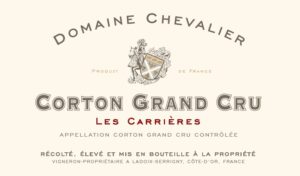
Corton Grand Cru Les Carrières
Note: 2021 will be the last vintage for the Carrières from Domaine Chevelier as the parcel was sold after that harvest.
Production Area: 0.19 hectares
Soil: Clay-limestone
Grape Variety: Pinot Noir
Alcohol: 13.5%
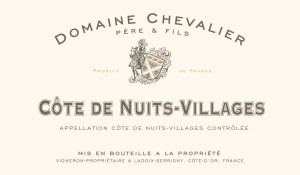
Côte de Nuits Villages
Location: 3 parcels located within the village of Corgoloin
Production Area: 0.01 hectares
Average Age of Vines: 50 years old
Annual Production: About 6,500 bottles
Grape Variety: 100% Pinot Noir
Vinification: Traditional vinification in temperature controlled vats for 10 days; the wine from the 3 parcels is blended at the end of vinification.
Aging: Maturation in oak barrels for 12 months
Tasting Notes: Well constituted wine with a fragrant bouquet that develops complexity with age. Solid cellaring potential.
Serving Temperature: 13-14°C
Food Pairings: Rustic or mousse patés, roasted or fried offal, pork (roasted or in sauce), roasted lamb, braised veal, and cheeses like Epoisses, Langres, and Ami du Chambertin.
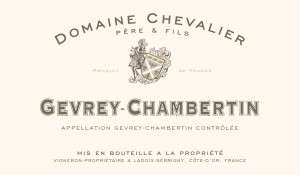
Gevrey-Chambertin
Location: This wine is produced from vines grown in the village of Gevrey Chambertin, in Côte de Nuits.
Production Area: 0.45 hectares
Grape Variety: 100% Pinot Noir
Annual Production: 2,200 bottles
Harvest: The grapes are hand picked at peak maturity. As soon as they are harvested, the grapes are meticulously sorted by a team on the sorting table.
Vinification: The grapes, destemmed slowly to keep them intact, are placed in vats. Then begins the work of vinification: daily monitoring, density measurement, temperature control, and tastings in order to decide on the conduct of the vatting. This is also when they decide on the duration of vatting, which is between 15-21 days depending on the vintage and the expression of the wine sought. The grapes and the musts are cooled prior to a long pre-fermentation maceration in order to extract the fruit of the wine to come. Extractions are slow and gentle thanks to the daily choice, after tasting, of either pigeage, délestage, or remontage. The goal is to create wines full of substance and fruit, reflecting the terroir. After devatting, the pressing is carried out in successive stages with tasting at each stage to decide on the incorporation into the final cuvée.
Aging: The wines are cooled and put into barrels: since 2008, in order to preserve the terroir and the fruitiness of the wines, only wines intended for long aging are aged with a proportion of new barrels, such as the Grands Crus. But all benefit from aging in oak wood, with barrels of 1 to 4 wines. After 10 to 12 months of aging on lees, the wines are then racked and blended in vats. The wines, neither fined nor filtered (with some exceptions) will be bottled at the beginning of the year, following the lunar calendar.
Serving Temperature: 15-16°C
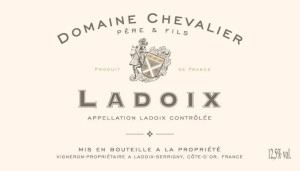
Ladoix Villages Rouge
Location: When coming from the direction of Dijon, it is at Ladoix that the Côte de Beaune begins, right near Aloxe Corton. Ladoix is located in the northern sector of the Côte de Beaune adjoining the Côte de Nuits vineyards. The village lies at the foot of the Coteau de Corton.
Soil: Chalk-marl
Production Area: 3.50 hectares
Grape Variety: 100% Pinot Noir
Average Age of Vines: 45 years old
Annual Production: About 20,000 bottles
Vinification: Traditional vinification in temperature controlled vats for 10 days
Aging: Maturation in oak barrels (25% in 1 year old barrels) for 12 months
Tasting Notes: Supple wine with fine tannins. Very aromatic, with cherry and raspberry notes.
Cellaring Potential: 8-12 years
Serving Temperature: 15-16ºC
Food Pairings: Parma-type hams, fibrous meats with subtle flavors like rabbit or boiled beef, giblets in sauce, feathered game, mild cheeses such as Vacherin, Reblochon, or Cïteaux.

Ladoix Villages Blanc
Location: The village of Ladoix is located north of the Côte de Beaune and the limit of the Côte de Nuits; it lies at the foot of the hill of Corton and the neighboring village of Aloxe Corton. The vineyards are oriented to the east and the southeast.
Production Area: 1.60 hectares
Grape Varieties: 75% Chardonnay; 25% Pinot Blanc
Soil: Clay limestone and marl
Annual Production: 2,000 bottles
Alcohol Content: 13%
Vinification: Débourbage for 24 hours; cooling down; alcoholic fermentation in oak barrels (25% new wood) for 11 months. Collage and light filtration before bottling.
Tasting Notes: Lovely bright golden color, with bouquet of citrus, honey, and sweet hay. The palate is medium-bodied and refreshing, with notes of lemon and stone fruit on the finish, along with gentle spice and hint of vanilla.
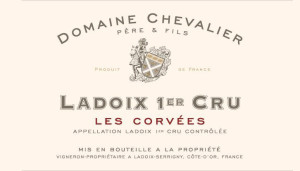
Ladoix Rouge 1er Cru Les Corvées
Location: The vineyard of Corvées is located in the village of Ladoix and faces to the east and southeast which gives good exposure to the vines.
Soil: Clay and chalk
Production Area: 1.85 hectares
Grape Variety: 100% Pinot Noir
Average Age of Vines: The vines used to produce this wine come from 2 parcels and range from 20-70 years old
Annual Production: 9,500 bottles
Vinification: Traditional vinification in temperature controlled vats for 10 days.
Aging: Maturation in oak barrels (25% in 1 year old barrels) for 12 months
Tasting Notes: Ladoix “Les Corvées” is a wine more powerful and racy than Ladoix Village. Beautiful bouquet with oak, pepper, and red fruits flavors. The complexities of this wine come to the fore with maturity.
Cellaring Potential: 8-12 years
Serving Temperature: 15-16°C
Food Pairings: Parma-type hams, fibrous meats with subtle flavors like rabbit or boiled beef, giblets in sauce, feathered game, mild cheeses such as Vacherin, Reblochon, or Cïteaux.
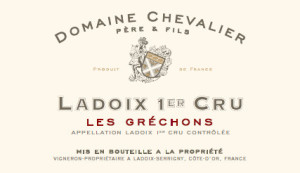
Ladoix Blanc 1er Cru Les Grechons et Foutrières
Location: This wine is produced from vines planted on a limestone hillside; the especially generous exposure makes excellent white wines with great class.
Production Area: 0.70 hectares
Grape Variety: 100% Chardonnay
Average Age of Vines: 17 years old
Annual Production: 3,500 bottles
Vinification: Débourbage for 24 hours. The wine is cooled before alcoholic fermentation in oak barrels (25% new wood) lasting 11 months. Fining and light filtration prior to bottling.
Tasting Notes: The ripeness of the grapes harvested for this wine is expressed on the palate. Very tasty notes of hazelnut praline. Long and racy finish.
Serving Temperature: About 12°C
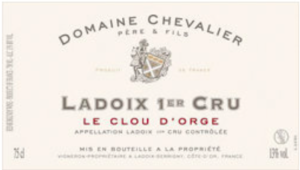
Ladoix 1er Cru Le Clous d'Orge
Location: The vines are planted to the southeast on the climat of “Clou d’Orge.”
Soil: Clay & chalk
Production Area: 0.85 hectares
Grape Variety: 100% Pinot Noir
Average Age of the Vines: 50 years-old
Annual Production: 4,500 bottles
Vinification: Traditional vinification in vats for 10 days with temperature control.
Aging: In oak barrels for 12 months (25% in 1 year old barrles)
Tasting Notes: Ladoix « Le Clou d’Orge » is more powerful and racy than Ladoix Village. Beautiful bouquet with oak, pepper, and ripe red fruit notes. On the palate, this wine is supple, rounded, full and structured with just the right amount of tannins.
Serving Temperature: 15-16°C
Food Pairings: Parma-type hams or fibrous meats with subtle flavors like rabbit. Giblets in sauce or feathered game. It goes well with mild cheeses such as Vacherin, Reblochon, or Cïteaux.
Domaine Chicotot (Certified Organic)
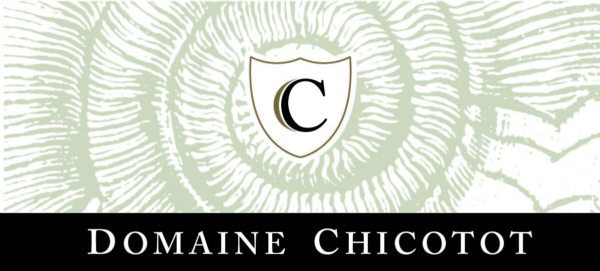
The Estate
In existence since 1678, Domaine Chicotot is a family-owned estate located in the heart of Nuits-St-Georges. Tiny at a size of just over 7 hectares, the estate produces wines organically with very little intervention in the cellar. Their bottlings include Bourgogne Rouge, Ladoix Village, and several cuvées of Nuits-St-Georges Villages (Aux Allots, Les Charmottes, Plants au Baron, Vieilles Vignes) and Nuits-St-Georges 1er Cru (Les Rues de Chaux, Les Pruliers, Aux Toreys, Les Vaucrains, and Les Saint Georges). All wines are aged at least 2 years in the cellar with 6 months bottle aging.
The current winemaker is the Alsatian-born Pascale Chicotot. Originally a banker, her life changed when she met Georges Chicotot during a trip to the estate in the early 1990s. They soon married and started making wine together – starting in 1993, Pascale was responsible for the vinifications. In 2008 Georges retired, after which Pascale took over as winemaker and manager of Domaine Chicotot, aided by their son Clément.
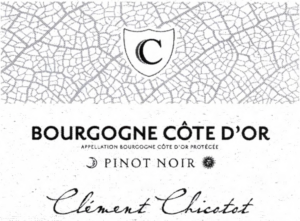
Bourgogne Côte-d'Or Pinot Noir
Grape Variety: Pinot Noir
Soil: Reddish brown soils containing residue of flintstone-encrusted limestone.
Average Age of the Vines: 70 years old
Production Area: 2.46 hectares
Vinification: After a few days of pre-fermentation maceration (5–6 days), fermentation takes place over about 15 days, without adding yeast. The cap-punching and pumping over operations are carried out as necessary to preserve all of the wine’s elegance without excessive extraction. After pneumatic pressing and several days in vats, the wines are racked off by gravity, with the proportion of new barrels no greater than 25%.
Tasting Notes: This very aromatic wine is a harmony of elegance and structure.

Ladoix Rouge
Terroir: Set in the bottom of the coomb, with brown, flinty, chalky soil.
Grape Variety: 100% Pinot Noir
Average Age of the Vines: 60 years old
Production Area: 0.50 hectares
Vinification: After a few days of pre-fermentation maceration (5–6 days), fermentation takes place over about 15 days, without adding yeast. The cap-punching and pumping over operations are carried out as necessary to preserve all of the wine’s elegance without excessive extraction. After pneumatic pressing and several days in vats, the wines are racked off by gravity, with the proportion of new barrels no greater than 25%.
Tasting Notes: A delight to drink while young, this fruity wine offers notes of raspberries, candied cherries that become finer as it ages, developing more spicy accents of cloves, cocoa and licorice. Its smooth tannins and well-rounded texture make it ideal to serve with smoked ham, rabbit, pot au feu, offal in sauce. It also goes well with curried poultry dishes, or game birds.
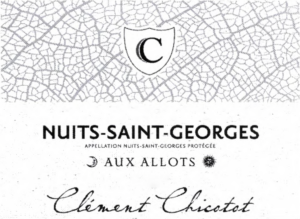
Nuits-Saint-Georges Aux Allots
Soil: Clay soils with much chert (hard, fine-grained sedimentary rock).
Grape Variety: 100% Pinot Noir
Average Age of the Vines: 70 years old
Production Area: 0.67 hectares, split into 5 plots.
Vinification: After a few days of pre-fermentation maceration (5–6 days), fermentation takes place over about 15 days, without adding yeast. The cap-punching and pumping over operations are carried out as necessary to preserve all of the wine’s elegance without excessive extraction. After pneumatic pressing and several days in vats, the wines are racked off by gravity, with the proportion of new barrels no greater than 25%.
Tasting Notes: With hints of ripe red fruit and blackcurrants, its complex nose is a gentle union of raspberries, licorice and soft spices that reveal its elegant, fruity character.

Nuits-Saint-Georges Les Charmottes
Terroir: Deep, chalky soils. In the Burgundian dialect, “Charmottes” (or “charmes”) refers to fallow land.
Grape Variety: Pinot Noir
Average Age of the Vines: 75 years old
Production Area: 0.29 hectares
Vinification: After a few days of pre-fermentation maceration (5–6 days), fermentation takes place over about 15 days, without adding yeast. The cap-punching and pumping over operations are carried out as necessary to preserve all of the wine’s elegance without excessive extraction. After pneumatic pressing and several days in vats, the wines are racked off by gravity, with the proportion of new barrels no greater than 25%.
Tasting Notes: An intense wine with elegant tannins, floral notes (peonies and violets), and luscious accents of red berries. This is a wine for sharing with friends – it is frank, pleasant, and perfect for every occasion. It is perfect with roast meats such as lamb or pork, with game bird, or with a selection of soft cheeses.
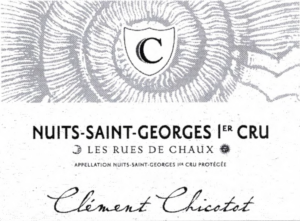
Nuits-Saint-Georges 1er Cru Rues de Chaux
Terroir: Reddish brown soil. Limestone over a layer of cracked bedrock. This plot is named Rues de Chaux – a reference to the rocky plateau upon which the vines are planted.
Grape Variety: Pinot Noir
Average Age of the Vines: The portion at higher elevation was replanted after the frost of 1985, and the vines planted at lower elevation are about 75 years old.
Production Area: 0.29 hectares
Vinification: After about 5-6 days of pre-fermentation maceration, fermentation takes place and lasts about 15 days (no added yeasts). Pigeage and remontage are carried out as needed in order to preserve the elegance of the wine without an excess of extraction. After pneumatic pressing for several days in tanks, the wine is transferred by gravity to barrels (new wood not exceeding 25%).
Tasting Notes: Floral, red fruit, and gentle spiced notes on the nose. Its structure becomes more supple over time and develops a beautiful aromatic complexity and great finesse.
Food Pairings: Pairs well with traditional Burgundian cuisine, such as roast chicken and sautéed mushrooms. Avoid pairing with fatty/creamy cheeses.
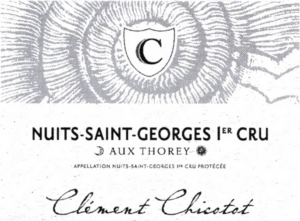
Nuits-Saint-Georges 1er Cru Aux Thorey
Terroir: Brown, gravelly soils with rock fragments
Grape Variety: Pinot Noir
Average Age of the Vines: 70 years old
Production Area: 0.32 hectares
Vinification: After a few days of pre-fermentation maceration (5–6 days), fermentation takes place over about 15 days, without adding yeast. The cap-punching and pumping over operations are carried out as necessary to preserve all of the wine’s elegance without excessive extraction. After pneumatic pressing and several days in vats, the wines are racked off by gravity, with the proportion of new barrels no greater than 25%.
Tasting Notes: Thanks to its solid structure, this wine is a good candidate for cellaring. Its aromatic range plays on pitted fruits, floral and licorice notes that develop more animal, woody notes as the wine ages.
Food Pairings: Goes well with most meats and sauces, and cheeses such as Brie or Camembert.
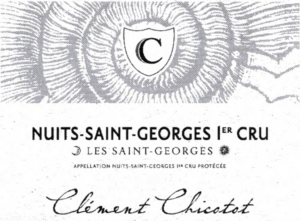
Nuits-Saint-Georges 1er Cru Les Saint Georges
Terroir: Brown soils, deep limestone and very stony. This was the first plot to be planted with vines in the year 1000.
Grape Variety: Pinot Noir
Average Age of the Vines: Planted in 1942
Production Area: 0.22 hectares
Vinification: After a few days of pre-fermentation maceration (5–6 days), fermentation takes place over about 15 days, without adding yeast. The cap-punching and pumping over operations are carried out as necessary to preserve all of the wine’s elegance without excessive extraction. After pneumatic pressing and several days in vats, the wines are racked off by gravity, with the proportion of new barrels no greater than 25%.
Tasting Notes: The aromatic range plays on black fruits (blueberries, blackberries) and spices mixed with more animal notes (musk and fur), especially for the somewhat older vintages. This is a powerful, complex wine with a nice structure that lets it face the years without fear.
Food Pairings: Being full-bodied, this Saint Georges goes well with spicy dishes, game (either marinated or not), tarts, meat dishes with mushroom sauces, and ripened cheeses.

Nuits-Saint-Georges 1er Cru Les Pruliers
Terroir: The plot of “Les Pruliers” has deep soils with a thin layer of clayey, sticky soil. Its name descends from Roman times; popular cherry trees of the variety prunus were grown here until the Middle Ages.
Grape Variety: Pinot Noir
Average Age of the Vines: 75 years old
Production Area: 0.09 hectares
Vinification: After a few days of pre-fermentation maceration (5–6 days), fermentation takes place over about 15 days, without adding yeast. The cap-punching and pumping over operations are carried out as necessary to preserve all of the wine’s elegance without excessive extraction. After pneumatic pressing and several days in vats, the wines are racked off by gravity, with the proportion of new barrels no greater than 25%.
Tasting Notes: Les Pruliers reveals very fruity notes of prune, red fruit (with blackberries and cherries often dominant), complemented by floral, smoky notes. This is a wine whose superb structure, powerful and sometimes a bit austere, makes it a good candidate for cellaring.
Food Pairings: It is a perfect accompaniment for traditional wine-based dishes, such as beef bourguignon and coq au vin. It also goes well with fruity cheeses such as comté, but not with ripened or very fatty cheeses.
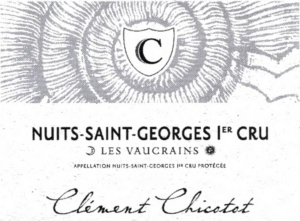
Nuits-Saint-Georges 1er Cru Les Vaucrains
Terroir: Les Vaucrains is located on a bed of red clays with a rich, loamy, stony soil. The name of this climat comes from two Burgundian dialect words describing its valley-like shape (Vau) forming a crack in the hillside (Crain).
Grape Variety: Pinot Noir
Average Age of the Vines: Vines planted in 1942
Production Area: 0.24 hectares
Vinification: After a few days of pre-fermentation maceration (5–6 days), fermentation takes place over about 15 days, without adding yeast. The cap-punching and pumping over operations are carried out as necessary to preserve all of the wine’s elegance without excessive extraction. After pneumatic pressing and several days in vats, the wines are racked off by gravity, with the proportion of new barrels no greater than 25%.
Tasting Notes: An intense, dark wine of outstanding power, its aromatic range plays on wild berries (blackberries and sloes), developing muskier, woodier notes and a body that mellows with time.
Food Pairings: It is the ideal accompaniment to full-flavored meats; roast game – such as woodcock, hare, wild boar, venison, for example – or rich, saucy dishes with mushrooms will match it perfectly, especially the older vintages.

Nuits-Saint-Georges Les Plantes au Baron
Location: Nuits-Saint-Georges Les Plantes Aux Baron is a small village lieu-dit situated just below the first-rate Premier Cru Les Didiers.
Soil: Clay limestone
Grape Variety: Pinot Noir
Average Age of the Vines: 70 years old
Production Area: 0.15 hectares
Vinification: After a few days of pre-fermentation maceration (5–6 days), fermentation takes place over about 15 days, without adding yeast. The cap-punching and pumping over operations are carried out as necessary to preserve all of the wine’s elegance without excessive extraction. After pneumatic pressing and several days in vats, the wines are racked off by gravity, with the proportion of new barrels no greater than 25%.
Tasting Notes: Full of character, this wine combines beautiful balance with finesse. The rich, complex nose has lovely leather notes with touches of musk. Blackberry, blackcurrant, and raspberry notes dominate, backed by discreet licorice accents.
Food Pairings: This wine is the ideal accompaniment to roast duck or capon.
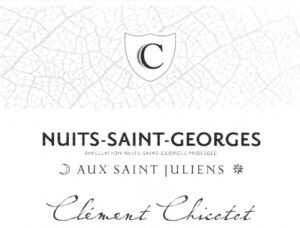
Nuits-Saint-Georges Aux Saint Juliens
Grape Variety: Pinot Noir
Average Age of the Vines: 60 years old
Production Area: 0.22 hectares
Vinification: After a few days of pre-fermentation maceration (5–6 days), fermentation takes place over about 15 days, without adding yeast. The cap-punching and pumping over operations are carried out as necessary to preserve all of the wine’s elegance without excessive extraction. After pneumatic pressing and several days in vats, the wines are racked off by gravity, with the proportion of new barrels no greater than 25%.
Winemaker Tasting Notes: “A subtle wine with very fine tannins; fine and delicate floral (peony) and cherry aromas both on the nose and on the palate – even lace-like in the mouth, with good persistence. Will pair well with white meat.”
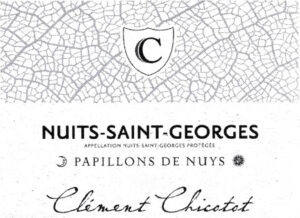
Nuits-Saint-Georges Les Papillons de Nuys
Terroir: This is our cuvée that draws from a wide range of plots dotted around the Nuits-Saint-Georges ‘village’ appellation, where herbs and trees can be found among the vines. Although these were often singled out as enemies in the past, in reality they are very good accomplices to the vines with wonderful qualities. ‘Nuyts’ was the name of the village before it became ‘Nuits’ at the end of the 18th century; and just like other wine villages, it was later assigned another name, that of its best cru – Saint-Georges. Alice Midol-Monnet helped create an attractive bottle to highlight the work – both in-depth and invisible, rooted in our soils – and the beauty of nature, capable of delighting us by breaking up the monotony of vineyards where gardens and orchards have become rare. As descriptive language may seem like just words, and as actions always hold more value, we really needed her artistic soul to allow us to express it better.
Grape Variety: Pinot Noir
Average Age of the Vines: 85 years old
Production Area: 1.16 hectares
Vinification: After a few days of pre-fermentation maceration (5–6 days), fermentation takes place over about 15 days, without adding yeast. The cap-punching and pumping over operations are carried out as necessary to preserve all of the wine’s elegance without excessive extraction. After pneumatic pressing and several days in vats, the wines are racked off by gravity, with the proportion of new barrels no greater than 25%.
Tasting Notes: An intense wine with elegant tannins and floral notes (peonies and violets), with luscious accents of ripened red berries.
Food Pairings: A wine for sharing with friends; it is frank, pleasant, perfect for every occasion. It is ideal with roast meat such as lamb or pork, with game bird or a selection of soft cheeses.
Domaine Coillot Pere & Fils – Côte de Nuits

The Estate
Domaine Coillot was established in the village of Marsannay in the 1960s by Bernard Coillot, father of current owner Christophe Coillot. The estate is 11 hectares spread out over 12 different appellations. The vines range from 20-65 years of age, with yields that never exceed 32-40 hectoliters per hectare. Due to the low yields, production is small, with about 50,000 bottles of wine produced annually. Christophe’s philosophy is to make terroir-driven wines as naturally as possible, with the least amount of intervention in the vineyard. The estate practices sustainable farming and does not use insecticides, pesticides, or herbicides. Harvest is done by hand, and there is no addition of yeasts, enzymes, or any chaptalization during vinification. Fermentation takes place during a period of 20-30 days under strict temperature control. This is followed by 18 months of aging in oak barrels (some new wood used).

Bourgogne Rouge
Grape Varietals: 100% Pinot Noir
Harvest: Harvest is done by hand, with table sorting done in the vineyard.
Vinification: 100% destemming. There is no addition of yeasts, enzymes, or any chaptalization during vinification. Fermentation takes place during a period of 20-30 days under strict temperature control.
Aging: 18 months of aging in oak barrels (some new wood used). Bottling without fining or filtration.
Tasting Notes: Aromas of dense, rich, lush fruits with notes of conifer and evergreen; long, persistent finish.
Serving Suggestions: Serve between 14-15°C

Gevrey Chambertin Vieilles Vignes
Average Age of the Vines: 50 years old
Plantation Density: 10,000 plants/ha
Average Yield: 35 hl/ha
Grape Varietals: 100% Pinot Noir
Vinification: Harvest is done by hand, with table sorting done in the vineyard. 100% destemming. There is no addition of yeasts, enzymes, or any chaptalization during vinification. Fermentation takes place during a period of 20-30 days under strict temperature control. This is followed by 18 months of aging in oak barrels (some new wood used). Bottling without fining or filtration.
Tasting Notes: On the palate, this wine has high concentration, silky tannins, and a fleshy feel on the tongue. Its fruity notes are embellished by a beautiful freshness. The finish is very long and frank with aromas of blueberry cream and black cherry jam.
Serving Suggestions: Serve between 16-18°C
Marsannay La Charme aux Pretres
Grape Varietals: 100% Pinot Noir
Plantation Density: 10,000 plants/ha
Average Yield: 42 hl/ha
Vinification: Harvest is done by hand, with table sorting done in the vineyard. 100% destemming. There is no addition of yeasts, enzymes, or any chaptalization during vinification. Fermentation takes place during a period of 20-30 days under strict temperature control. This is followed by 18 months of aging in oak barrels (some new wood used). Bottling without fining or filtration.
Tasting Notes: Deep garnet red with bluish highlights. Aromatic, revealing notes of berries (cherry, blackcurrant) with a hint of spice. Full and rich on the approach, the sublime fruity tannins coat the palate with great finesse and subtlety. Long, velvety finish.
Serving Suggestions: Decant 1 hour prior to serving. Serve between 16-18°C.

Marsannay Les Boivins
Grape Varietals: 100% Pinot Noir
Plantation Density: 10,000 plants/ha
Average Yield: 35 hl/ha
Vinification: Harvest is done by hand, with table sorting done in the vineyard. 100% destemming. There is no addition of yeasts, enzymes, or any chaptalization during vinification. Fermentation takes place during a period of 20-30 days under strict temperature control. This is followed by 18 months of aging in oak barrels (some new wood used). Bottling without fining or filtration.
Tasting Notes: A melange of black olive and black cherry notes with a small amount of oak are expressed on the palate, with a long finish that reveals lush fruit flavors along with a nice minerality.
Serving Suggestions: Serve between 14-15°C

Marsannay Les Grasses Têtes
Grape Varietals: 100% Pinot Noir
Harvest: Harvest is done by hand, with table sorting done in the vineyard.
Vinification: 100% destemming. There is no addition of yeasts, enzymes, or any chaptalization during vinification. Fermentation takes place during a period of 20-30 days under strict temperature control.
Aging: 18 months of aging in oak barrels (some new wood used). Bottling without fining or filtration.
Tasting Notes: The nose is very pleasant with notes of roasted meat and violet petal. The palate is fresh and pure with a minerality that is complemented by a lovely fruitiness.
Serving Suggestions: Decant 1 hour before serving. Serve between 16-18°C.

Marsannay Les Ouzelois
Location: Les Ouzelois is a well-sited plot at the northernmost point of Marsannay-la-Côte. It is set to become premier cru at the next revision of Burgundy’s complicated Appellation Controllé system. Les Ouzelois is only 5.4 ha and is a direct extension of Marsannay’s 2 most famous lieu-dits of Les Longeroies and Clos du Roy.
Production Area: 0.52 ha
Average Age of the Vines: 45-55 years old
Soil: Clay-limestone, rocky with good drainage
Grape Varieties: Pinot Noir
Harvest: Manual
Vinification: Harvest is done by hand, with table sorting done in the vineyard. 100% destemming. There is no addition of yeasts, enzymes, or any chaptalization during vinification. Fermentation takes place during a period of 20-30 days under strict temperature control.
Aging: 12 months of aging in oak barrels (30% new wood). Bottling without fining or filtration.
Tasting Notes: Notes of blackcurrant, cherry, and blackberry; fleshy on the palate.
Domaine Darviot-Perrin (Biodynamic)

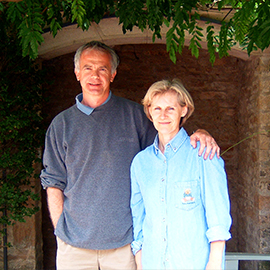
The Estate
Didier Darviot learned the winemaking trade from his wife Geneviève’s father, Pierre Perrin, from whom he also acquired some prime vineyards with older vines in the Côte de Beaune. Pierre was a legendary figure in the wine making echelons of Meursault and Volnay.
The first commercial bottling was a handful of cases of the 1989 vintage. In 2001, a family succession brought a prime half-hectare plot of 1er Cru Meursault Genèvrieres to round out the range of exquisite Meursault vineyards. The other jewels in the crown are the Blanchots-Dessus 1er Cru in Chassagne – literally under Montrachet and the Volnay Les Blanches and 1er Crus Gigotte and Santenots. The estate today spans 11 hectares and is internationally considered one of the finest sources of red & white Burgundy.
It is an emphasis on the work in the vineyard which makes the difference at Darviot-Perrin. The vineyards are tended biodynamically which is just a small part of making fine Burgundy. The vital element is bringing healthy, ripe grapes to the presses and vats. Vinification is important, but cannot replace impeccable fruit from the vineyard. “Minimal intervention” is the watchword in the cellar, which is naturally cold and moist. Malolactic fermentations frequently take almost a year to complete, enhancing the complexity and quality of the wines.
Didier officially retired in 2017, and in 2019, Didier’s son Pierre-Antonin took over winemaking duties after having worked for years in the foreign service. He learned from the best – his father, a master vigneron and one of the most meticulous and thoughtful winemakers in Burgundy. In just a short period of time, Pierre-Antonin has made the switch to 100% biodynamic production.
The Vines
The vineyards of Darviot-Perrin are ploughed and they use organic compost as fertilizer, and they use no insecticides or weedkiller. The average age of the vines is 60 years, with some that are upwards of 90 years old.
The Harvest
The grapes are sorted by hand while still on the vine so that when the harvest is finally transported to the cellar, there is minimal intervention required.
Vinification
For the red wines, the grapes are nearly 100% destemmed, followed by cold maceration lasting 5-6 days. The grapes are crushed with great care, and the winemakers take their time with the fermentation process, keeping the temperature low and the extraction gentle. The cuvaison, or period during fermentation when the wine is in contact with the pomace, lasts 8 days for the Chassagne and 15-17 days for the Volnay.
The white grapes are pressed in whole bunches, undergo debourbage for 24 hours, and then the resulting wine is fermented using indigenous yeasts in barrels at a controlled temperature of 18-20°C.
Aging
For the red wines, they are left to mature in 25% new Nevers oak barrels on the fine lees for 18 months-no racking, fining, or filtration. For the whites, they are aged in 25% new Allier oak barrels for 12 months with one racking and finally 6 months in steel vats; fining but no filtration.
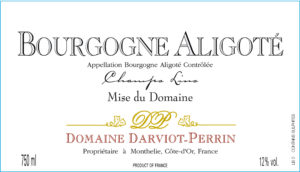
Bourgogne Aligoté Champs Lins
Location: This plot is called Champs-Lin, and is planted with cordon trained 60-year old vines situated by the railway.
Grape Variety: 100% Aligote
Vinification: The grapes are pressed in whole bunches, undergo debourbage for 24 hours, and then the resulting wine is fermented using indigenous yeasts in barrels at a controlled temperature of 18-20°C.
Aging: Aged in 25% new Allier oak barrels for 12 months with one racking and finally 6 months in steel vats; fining but no filtration.
Tasting Notes: Fresh with brisk acidity and ripened citrus fruit notes.
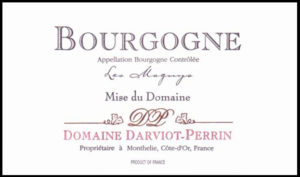
Bourgogne Blanc Les Magnys
Location: Same plot as Les Magny red, lying east of the village, between the residences of Mr. Coche and Mr Roulot.
Production Area: 0.22 hectares
First Planting: 1953
Grape Variety: 100% Chardonnay
Average Age of the Vines: 60+ year old vines in Meursault
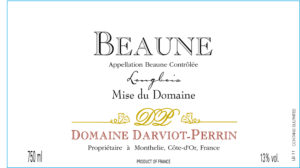
Beaune Longbois
Location: 15 year old vines planted at the top of the hill overlooking Beaune.
Soil: Shallow and stony clay and limestone soil.
Grape Variety: 100% Chardonnay
Vinification: The grapes are pressed in whole bunches, undergo debourbage for 24 hours, and then the resulting wine is fermented using indigenous yeasts in barrels at a controlled temperature of 18-20°C.
Aging: Aged in 25% new Allier oak barrels for 12 months with one racking and finally 6 months in steel vats; fining but no filtration. Bottling done at the estate.
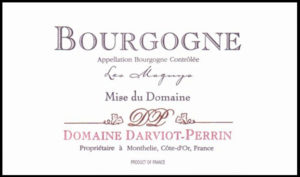
Bourgogne Rouge Les Magnys
Location: Les Magnys plot is located just above L’Hopital de Meursault. Darviot-Perrin’s plot is in the Bourgogne appellation and is planted partly with Chardonnay and part with Pinot Noir. Both are labelled as Les Magnys.
Production Area: 0.22 hectares
Grape Varieties: Pinot Noir
First Planting: Early 1960s
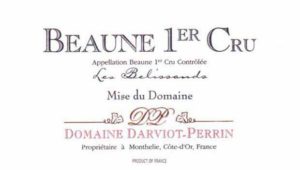
Beaune 1er Cru Les Bellisands
Size of Plot: 0.51 ha
First Planting: 1940
Tasting Notes: A completely different nose of higher-toned and airy raspberry and red cherry notes that complement the supple, round and slightly more concentrated flavors underpinned by pliable and fine tannins, all wrapped in a velvety, mouth coating finish.
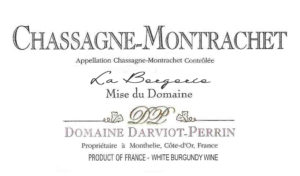
Chassagne-Montrachet La Bergerie
Location: 250 meters south of Montrachet – not far from the premier cru Les Blanchots-Dessus.
Size of Plot: 0.46 ha
First Planting: 1920’s
Annual Production: 1,200 bottles
Tasting Notes: Pale gold color with green tints. On the nose, this wine is fresh and floral; the multi-faceted bouquet promises latent complexity. The palate is broad and expressive, yet compact with flavor. An almost Premier Cru structure; very long, persistent finish.
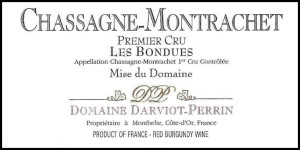
Chassagne-Montrachet Rouge 1er Cru Les Bondues
Location: “Les Bondues” is a small, prestigious, eastern-facing Premier Cru vineyard located just south of Chassagne-Montrachet, 100 yards south of Montrachet. Bondues is a lieu-dit within Chenvottes. The Darviots are the only vignerons to have Pinot Noir in this particular vineyard.
Size of Plot: 0.32 ha
First Planting: 1969
Production: 1,400 bottles
Tasting Notes: Almost garnet in color with a deep rim. The bouquet is full of deep, brooding red fruit with polished wood notes. This is a robust and meaty full-bodied wine.
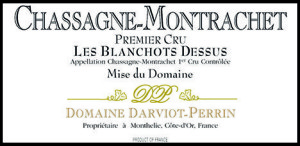
Chassagne-Montrachet 1er Cru Blanchots Dessus
Location: Tiny, 50 year old 1er Cru vineyard situated immediately to the south of Montrachet, known to locals as “Pieds du Montrachet.”
Size of Plot: 0.30 ha
First Planting: 1969
Soil: Gravelly limestone
Production: 1,800 bottles
Varietal Blend: 100% Chardonnay
Tasting Notes: Golden color with green tints. The bouquet is fresh and floral yet complex, with predominant notes of honeysuckle. On the palate, this wine is discreet at the start, but opens up to a lovely brilliance and long lasting finish.
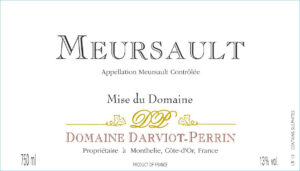
Meursault
Vineyard Plots: The Meursault is produced from two plots: Les Corbins and Les Clous.
Average Age of the Vines: 40-50 years old
First Year of Production: 2022
Grape Variety: Chardonnay
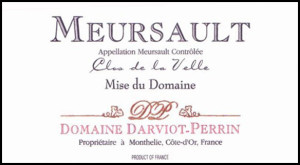
Meursault Clos de la Velle
Location: A vineyard toward the eastern extremity of the village; a monopole of the family Darviot
Size of Plot: 0.56 ha
First Planting: 1949
Production: 3,000 bottles
Tasting Notes: Pale gold in color with green tints. The bouquet has a softly mineral aroma with hints of citrus fruit when young. The palate is loose-knit, with a broad structure; it is a round, ample wine with an appealing, biscuity finish.
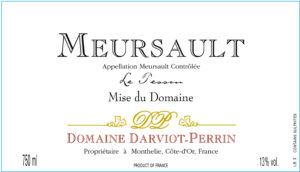
Meursault Le Tesson
Location: This is the youngest vineyard of the Domaine, planted in 1980 with the same altitude and aspect as Perrières.
Size of Plot: 0.16 hectares
Grape Variety: 100% Chardonnay
Vinification: The grapes are pressed in whole bunches, undergo debourbage for 24 hours, and then the resulting wine is fermented using indigenous yeasts in barrels at a controlled temperature of 18-20°C.
Aging: Aged in 25% new Allier oak barrels for 12 months with one racking and finally 6 months in steel vats; fining but no filtration.
Tasting Notes: Gold color with green tints. The bouquet is stylish and racy, with fresh, floral flares. On the palate, it has good structure and weight with fine fleshiness; a long, elegant finish.
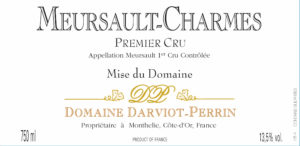
Meursault 1er Cru Charmes
Location: Darviot-Perrin’s vines in Les Charmes are in the upper Charmes Dessus section of the climat.
Size of Plot: 0.31 ha
First Planting: 1965
Grape Variety: 100% Chardonnay
Tasting Notes: This is a fine, crisp wine with more minerality than one would normally find in this cru.
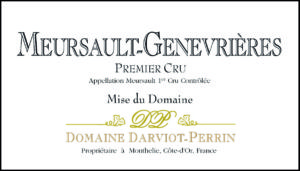
Meursault 1er Cru Genevrières
Location: Lies quite close to Perrières
Production Area: 0.41 hectares
First Planting: 1951
Inaugural Vintage: 2001
Annual Production: 2,500 bottles
Tasting Notes: Pale gold color. The bouquet has notes of ripe peach and apricot. On the palate, this wine is broad and rich with huge power, and a long, caramel, and brûléed peach finish.

Meursault 1er Cru Perrières
Location: Aux-Perrières, a property that is shared between Domaine Darviot-Perrin and Coche-Dury. It is a Premier Cru vineyard located in the southern portion of Meursault, at one of the highest elevations of the Cote d’Or
Soil: Thin and rocky, with a predominance of limestone
Size of Plot: 0.29 ha
First Planting: 1937
Production: 1,500 bottles
Tasting Notes: Golden with silver tints. A lovely minerality is present in the bouquet; complex, yet refined and discreet. The palate has depth; it has a dense and suave mouth feel with tight acidity; rich and satiny texture.
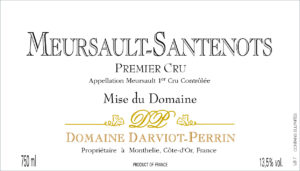
Meursault 1er Cru Santenots
Grape Variety: Chardonnay
Location: Immediately above Clos des Chênes, 80 year old vines
Size of Plot: 0.10 ha
First Planting: 1941
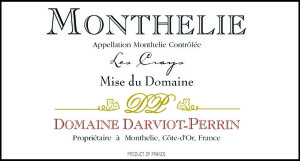
Monthelie Les Crays
Location: Situated in the small village of Monthelie in Cote de Beaune
Soil: Monthelie Les Crays is home to dry soils which the winemaker, Didier Darviot, is continually attempting to enrich with organic compost
Size of Plot: 0.19 ha
First Planting: 1982
Annual Production: 900 bottles
Tasting Notes: Very dark ruby in color. Intense dark fruit aromas; very attractive ripe, juicy fruit on the palate. Silky-fine tannins, really remarkable for a Monthélie
Food Pairings: Veal, pork, game (deer, venison), rich fish (salmon, tuna etc), poultry
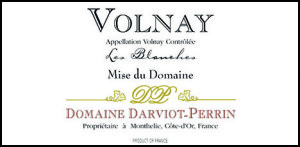
Volnay Les Blanches
Location: Immediately above le Clos des Chênes, southern facing vineyard
Soil: Limestone rich
Size of Plot: 0.86 ha
First Planting: 1949
Production: 2,500 bottles
Tasting Notes: Deep ruby red in color. The nose has notes of wild strawberry jam and hints of violet. Elegant and rich on the palate.
Food Pairings: Veal, pork, game (deer, venison), rich fish (salmon, tuna etc), poultry

Volnay 1er Cru La Gigotte
Location: Immediately above le Clos des Chênes, southern facing vineyard. The frontier between village Volnay and 1er Cru dissects the Gigotte vineyard. Only the top triangle is classified as 1er Cru where there are 2 proprietors: Darviot-Perrin and Domaine Perrin in Volnay.
Soil: Limestone rich
Size of Plot: 0.86 ha
First Planting: 1949
Production: 2,500 bottles
Tasting Notes: Deep ruby red in color. The nose has notes of wild strawberry jam and hints of violet. Elegant and rich on the palate.
Food Pairings: Veal, pork, game (deer, venison), rich fish (salmon, tuna etc), poultry
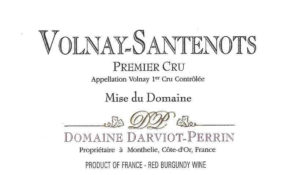
Volnay-Santenots 1er Cru
Location: Immediately above Clos des Chênes, 50 year old vines
Size of Plot: 0.81 ha
Production: 2,500 bottles
Vinification: The grapes are nearly 100% destemmed, followed by cold maceration lasting 5-6 days. The grapes are crushed with great care, and the winemakers take their time with the fermentation process, keeping the temperature low and the extraction gentle. The cuvaison, or period during fermentation when the wine is in contact with the pomace, lasts 15-17 days for the Volnay.
Aging: Matured in 25% new Nevers oak barrels on the fine lees for 18 months – no racking, fining, or filtration.
Tasting Notes: Ruby color. The bouquet has hints of wild strawberry jam with violet petal overtones. Elegant, rich, and flavorsome on the palate. Long, ethereal finish.
Food Pairings: Veal, pork, wild game (deer, venison), rich fish (salmon, tuna etc), poultry
Domaine Éric Forest (Biodynamic)

The Estate
The Forest family has been making wine in the Maconnais region for 8 generations. However, André (Eric Forest’s grandfather), was the first of his family to dedicate himself to producing wine exclusively, and it was through him that Eric learned about winemaking and biodynamics. Eric also studied enology and worked in the Yakima Valley in 1996, as well as working two years with Jean-Marie Guffens. In 1999, Eric took over management of the estate and eventually expanded the size of the domaine to 8.9 hectares.
Eric cultivates vines on some of the finest terroirs in Vergisson, as well as a plot on the heights of Davayé. He produces five exclusive vintages of Pouilly-Fuissé, Saint-Véran, and Macon-Vergisson on plots of vines planted between 1930 and 1979. Everything is manually done on the estate, and he uses organic and biodynamic methods in the vineyards, but is not certified. The plants are pruned in a manner to allow for the vines to have ample ventilation, thus minimizing the need to use phytosanitary products. Eric combats any other plant species with an environmental approach by carrying out extra plowing to sustain the soil and to encourage the roots to absorb the rich qualities held within the terroir.
The winemaking process begins with a manual harvest followed by very gentle pressing. The wine stands on its lees for 10-15 months inside oak barrels with reduced doses of sulfites. The wine is then bottled by hand using gravity and often unfiltered. As a passionate winemaker, Eric brings the utmost care and attention to all stages of the winemaking process, a personal commitment to deliver the high standards representative of his terroir.
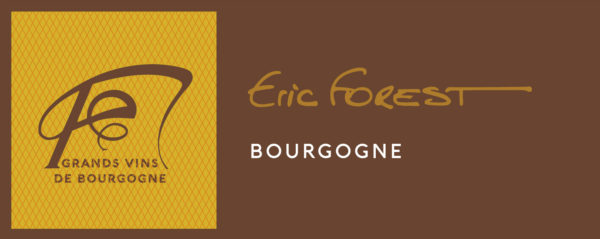
Bourgogne Blanc
Location: The Bourgogne Blanc is produced from a 0.20-hectare plot of vines planted in 2017 in Vergisson on the edge of the Pouilly-Fuissé appellation.
Terroir: The terroir begins at the bottom with beautiful blue marls and ends at the top with decomposed granite. The microclimate and the rather cool exposure, as well as the youth of the vines make a wine which lacks a little richness and structure. This is why Forest blends his Pouilly-Fuissé end-of-press wines, which have more volume and higher pH, with this vintage.
Grape Variety: Chardonnay
Vinification: 50% vinified in barrels and 50% in vats to maintain freshness and finesse.
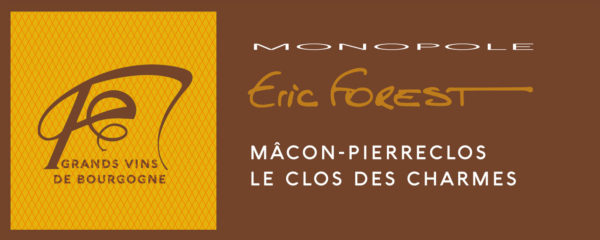
Mâcon-Pierreclos Monopole Le Clos Des Charmes
Overview: This 1.5-hectare geological unit of which Forest has the Monopole is planted with Chardonnay and produces very great, rich, and vibrant wines.
Average Age of the Vines: Almost a century old for the most part.
Exposure: South
Soil: Clay and colored marl on the outcropping limestone rock.
Grape Variety: Chardonnay
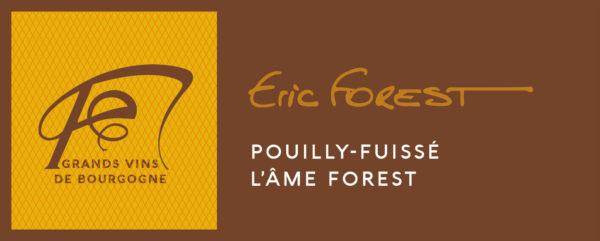
Pouilly-Fuissé L'Ame Forest
Terroir: l’Âme Forest is a blend of four cooler terroirs: the marls of “La Côte” give powerful, mineral structure as well as length on the finish, while the clay-limestone of the “Tilliers” and “Le Bois Rosier” bring finesse with notes of citrus and stone fruit. As for the old Carmentrants vines, they add richness and depth. The soul of this cuvée is born from a perfect balance of these plots planted by André (Eric’s grandfather), cultivated by Michel (his father), and taken over by Eric in 1999.
Vinification: The grapes are pressed very gently and over long periods of time, without crushing, and then fermented in cask on native yeast with much of the lees.
Aging: The wine is matured over two winters before bottling without filtration and with very little sulfur.
Tasting Notes: Born from the coolest areas of Vergisson, l’Ame Forest is a great way to discover the estate’s style. It is balanced, intense in energy, and very fresh on the palate.
Alcohol: 13%
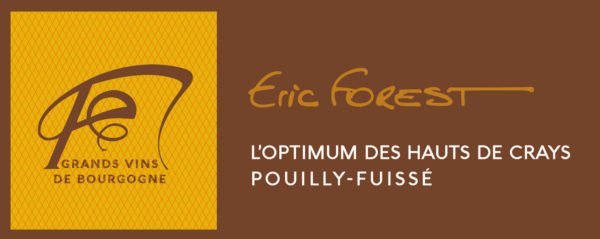
Pouilly-Fuissé L'Optimum Des Hauts De Crays
First Planting: 1930s
Grape Variety: Chardonnay
Harvest: End of September
Vinification: Fermented in fût and amphora
Alcohol: 15.42%
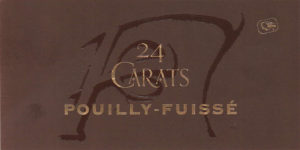
Pouilly-Fuissé 24 Carats
Notes: This micro cuvée is a blend of the best 3 or 4 barrels from Forest’s cellar. It is not produced for every vintage.
Location: Forest lovingly extract this cuvee from the most beautiful terroirs in Vergisson. 1/3 from La Roche plot and 2/3 from Les Crays plot.
Grape Variety: Chardonnay
Alcohol: 13.5%
Tasting Notes: 99.9% pure, this cuvee harmoniously reflects the power of the clay, the brilliance of the limestone, and the voluptuousness of Chardonnay.
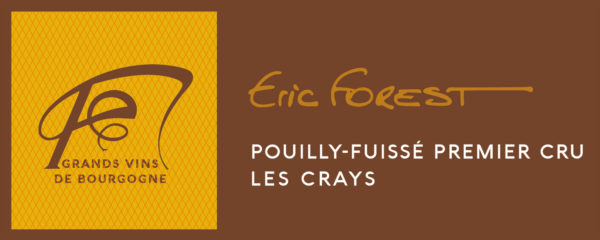
Pouilly-Fuissé 1er Cru Les Crays
Terroir: “Les Crays” is a terroir of limestone scree on blue Pliensbachian marl. This south-facing slope of the Vergisson rock, very bright and protected from the cool north wind, produces fatty wines with chiseled minerality and rich citrus aromas.
Production Area: 2.16 hectares
Age of the Vines: This cuvée is harvested from several plots planted between 1930 and 1966.
Vinification: The grapes are pressed very gently and over long periods of time, without crushing, and then fermented in cask on native yeast with much of the lees.
Aging: The wine is matured over two winters before bottling without filtration and with very little sulfur.
Alcohol: 13.5%
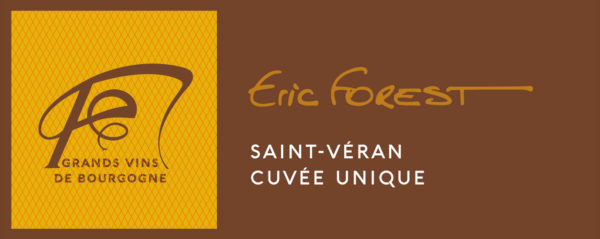
Saint-Véran Cuvée Unique
Overview: The severe frosts of April 2021 destroyed the majority of the vine buds. The very small harvest led Eric Forest to blend his two different plots of Saint-Véran to produce an exceptional Saint-Véran “Cuvée Unique”.
Appellation: Saint-Véran
Grape Variety: Chardonnay
Alcohol: 13%
Plots: Cuvée Unique is produced from 2 separate Saint-Véran plots:
Terre Noire –
Surface Area: 0.5 hectares in the town of Davayé
Average Age of the Vines: 80 years old. These old vines produce very small, thick-skinned grapes which give character and density to the wine.
Terroir: Terre Noire is a very great terroir for Chardonnay. Slightly sloping facing south, it is composed of 60-80 cm of brown clay on the surface on a very stony subsoil of white limestone with “entroque” or marine fossils.
La Côte Rôtie –
Surface Area: 0.5 hectares in the town of Davayé
Average Age of the Vines: Planted in 1979, over 40 years old.
Terroir: “La Côte Rôtie” is the name registered in the 19th century of a very steep limestone hillside facing south at the bottom of the valley. It is a sun-burnt oven where Forest harvests very ripe Chardonnay. The wines from this microclimate are very rich and bold with a “gastronomic” power.
Yield: 9 hl/ha
Harvest: Manual harvest into 50 kg boxes
Vinification: Soft and slow pressing, in bunches crushed by gravity. Vinification with natural yeasts in 3 barrels of 300 liters.
Aging: 12 months in barrels without racking and without stirring. Bottling by gravity without filtration or fining.
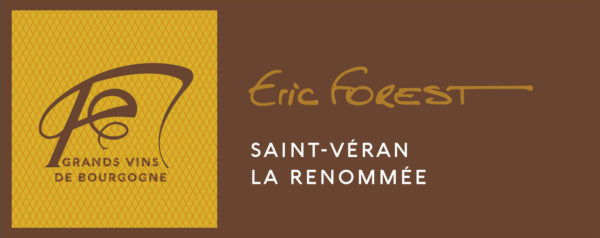
Saint-Véran La Renommée
Location: This very steep hillside of the Vergisson rock is an extension of “Les Crays” on the bottom of the valley.
Terroir: This is a very warm limestone terroir, sheltered from the winds and roasted by the sun.
Tasting Notes: This gourmet wine is ample and round.
Alcohol: 13.5%
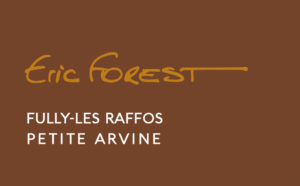
Petite Arvine Fully-Les Raffos
Overview: For his 20th vintage, Eric Forest had the opportunity to bring an old dream to reality: to create an ultra-confidential and absolutely superb Petite Arvine which comes from the most famous terroir in Valais Switzerland, Fully. To understand the origin of this passion for Petite Arvine, one has to go back in time – Eric’s father used to fill the family wine cellar with beautiful Swiss bottles selected by friends from Valais, where the Forest family often went on vacation. From adolescence, Eric familiarized himself with these whites, dry and sweet, and learned to love them for their complexity and many nuances.
In 2017, while on a tour with a Swiss importer, Eric met Pierre-Antoine Crettemand (meticulous winegrower in Saillon and owner of vines in Fully) whose family has been making wine for generations. Eric did not hesitate long before deciding to take the plunge and come to make wine by his side.
The Vines: The Fully Les Raffos is produced from old massal selections of Petite Arvine grown organically by Pierre-Antoine. The latter of course brings his intimate knowledge of the terroir and the vine, while Eric brings to the steep slopes of Fully a Burgundian spirit that is clearly found in the wine.
Vinification: Eric selects the optimal harvest date for the grapes. The vinification process starts with the extreme precision of Eric’s fractional pressings, for which he retains here only the press media, the purest juices that he vinifies without débourbage.
Aging: Eric follows the fermentation and aging by phone and goes to the winery himself every 3 months. The wine is aged in a small wine cave dug into the rock just below the Chateau de Fully. He uses the barrels of his Pouilly-Fuissé Les Crays which he brings from Vergisson, barrels already inoculated with the indigenous yeasts of Vergisson. After a year in barrels, the aging is extended for another 6 months on fine lees in stainless steel vats. Finally he carries out the bottling by gravity without filtration or fining.
Tasting Notes: The Petite Arvine Fully-Les Raffos is masterful in its refinement and balance. It is airy on the nose; one perceives notes of wildflowers and wild mountain herbs. Allowed to breathe, the sensual dimension of the wine asserts itself, with intertwined notes of grape jelly, poached peach or pear, and baked apple, suffused with many spices with Asian accents, between cumin, candied ginger, nutmeg and incense. On the palate, it is both generous, textured, and perfectly defined. Notes of pineapple, caramelized pear, and marmelade, enhanced by a touch of pepper. Fine bitterness reminiscent of green pepper, picholine olive, and cardamom tickle the taste buds on the finish. A full and expressive finish, with good length.
Alcohol: 13.5%
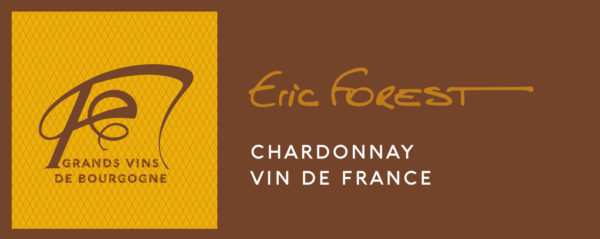
Chardonnay
Appellation: Vin de France
Location: Vines planted in Limoux
Alcohol: 13%
Domaine Eypert
The Estate
Driven by a passion for winegrowing, Domaine Eypert is a 6.3 hectare family estate established in 2011 in the heart of Tharoiseau, a charming village in the Vézelay AOC appellation area. The estate enjoys an exceptional setting, with a breathtaking view of Vézelay and its famous basilica. The majority of the vines planted are Chardonnay in the appellation AOC Vézelay, along with Pinot Noir and a few acres of Melon de Bourgogne.
Faithful to traditional winemaking methods, owner and winemaker Hervé Eypert allows nature to be fully expressed in the aromas of the wines, resulting in authentic and unique cuvées.
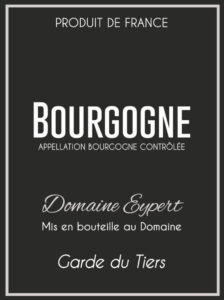
Bourgogne Garde Du Tiers
Terroir: Clay-rich soils of Tharoiseau in the Yonne department. This unique terroir imparts a light, fruit-forward profile, offering an elegant and approachable interpretation of Burgundy wines.
Grape Variety: Pinot Noir
Vinification: Crafted using traditional methods, this wine undergoes natural fermentation without added yeast or chaptalization.
Precise temperature control ensures its freshness and aromatic purity.
Tasting Notes: Versatile and inviting, Bourgogne Rouge can be enjoyed as an apéritif by those who appreciate lighter red wines, or as a perfect pairing with red meats and a wide selection of cheeses. Experience the finesse of Burgundy with this vibrant and expressive Pinot Noir.
Alcohol: 12.5%
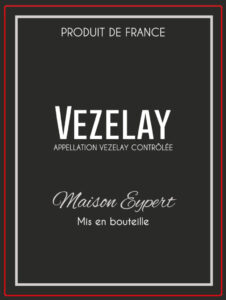
Bourgogne-Vézelay Blanc
Location: Produced in the prestigious Burgundy wine region, in the Yonne department in Asquins. This appellation covers four picturesque villages: Asquins, Saint-Père, Tharoiseau, and Vézelay.
Grape Variety: Chardonnay
Soil: Limestone
Altitude: Approximately 270 meters
Vinification: The winemaking process follows traditional methods: natural fermentation without added yeast or chaptalization, with precise temperature control to preserve the wine’s finesse.
Tasting Notes: The Vézelay, produced in Asquins, stands out for its freshness, minerality, and delicate fruit notes. Discover the elegance and authenticity of Vézelay – a wine that truly embodies the spirit of Burgundy.
Food Pairings: Perfect as an aperitif, it pairs beautifully with seafood, fish, and select aged cheeses such as Chaource.
Alcohol: 12.5%
Domaine Gérard Peirazeau et Fils

The Estate
Jules Groffier (1898-1974) acquired the first vineyard holdings of the domaine, which were later divided between his children: Robert Groffier and Bernadette Groffier. Bernadette married into the Peirazeau family and established “Domaine Peirazeau-Groffier.” Laurent Peirazeau, grandson of Bernadette and son of Gérard, decided to expand the family’s production from the 2019 vintage onward under the label “Gérard Peirazeau & Fils”.
Laurent, along with his partner Sophie Charlopin, who comes from a prominent wine family herself, manages a 3.65-hectare vineyard spread across 3 villages, including Morey St Denis, Chambolle-Musigny, and Gevrey-Chambertin. Although the vineyard is relatively small, it boasts exceptional terroirs and plot locations. The domain produces 13 appellations, 5 of which are among the most celebrated Grand Crus, including Chambertin Clos de Bèze, Charmes Chambertin, Clos de la Roche, Clos Saint-Denis, and Bonnes Mares. The majority of the vineyards consist of old vines, with an average age of 60 years.
The domaine practices sustainable cultivation using organic or biocontrol products, but is not certified. Plowing is limited, and weeding is rare.
In the cellar, Peirazeau does not use any added products; only native yeasts are used for fermentation. The red wines, except Coteaux Bourguignons and Bourgogne Pinot Noir, are all aged in oak barrels.
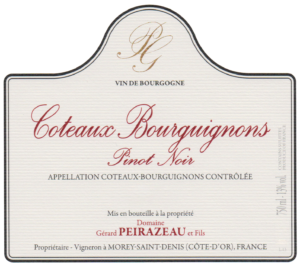
Coteaux Bourguignons Pinot Noir
Appellation: Coteaux Bourguignons
Grape Variety: Pinot Noir
Viticulture: The vineyard is cultivated using sustainable methods. Peirazeau uses organic products as much as possible and no pesticides. He shows respect for the subsoil with rigorous mechanical work by limiting passages in order to avoid compaction as much as possible.
Vinification: The harvest is entirely destemmed, to avoid excess tannins. In the cellar, Peirazeau has a minimal-intervention approach; he uses only indigenous yeasts and no added substances. The grapes are macerated in stainless steel tanks for 2-4 weeks with gentle manual pumping-over and punching-down for soft extraction.
Aging: In stainless steel tank.
Tasting Notes: Aromas of raspberries, cherries, and black pepper delight the palate. The tannins and acidity are well balanced, making it easy to drink.
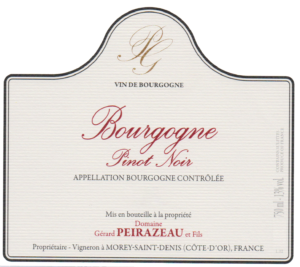
Bourgogne Pinot Noir
Vineyard Plot: The original plot was classified as a village appellation, but due to a revision of the land use plan the plot was downgraded.
Grape Variety: Pinot Noir
Viticulture: The vineyard is cultivated using sustainable methods. Peirazeau uses organic products as much as possible and no pesticides. He shows respect for the subsoil with rigorous mechanical work by limiting passages in order to avoid compaction as much as possible.
Vinification: The harvest is entirely destemmed, to avoid excess tannins. In the cellar, Peirazeau has a minimal-intervention approach; he uses only indigenous yeasts and no added substances. The grapes are macerated in stainless steel tanks for 2-4 weeks with gentle manual pumping-over and punching-down for soft extraction.
Aging: In stainless steel tank.
Tasting Notes: Classic. The Bourgogne Pinot Noir is marked by its vegetal nose. During its vinification, extractions are limited to guarantee freshness, roundness, and suppleness.

Morey-Saint-Denis Blanc
Grape Variety: Chardonnay
Viticulture: The vineyard is cultivated using sustainable methods. Peirazeau uses organic products as much as possible and no pesticides. He shows respect for the subsoil with rigorous mechanical work by limiting passages in order to avoid compaction as much as possible.
Vinification: The harvest is entirely destemmed, to avoid excess tannins. In the cellar, Peirazeau has a minimal-intervention approach; he uses only indigenous yeasts and no added substances. The grapes are macerated in stainless steel tanks for 2-4 weeks with gentle manual pumping-over and punching-down for soft extraction.
Aging: In oak barrels (around 30% new oak on average) for about 18 months, no racking. Light filtration before bottling.
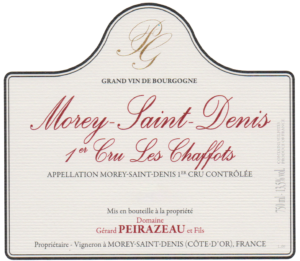
Morey-Saint-Denis 1er Cru Les Chaffots
Vineyard Plot: The plot is located above Clos Saint-Denis with very stony soil and a pronounced slope.
Grape Variety: Pinot Noir
Viticulture: The vineyard is cultivated using sustainable methods. Peirazeau uses organic products as much as possible and no pesticides. He shows respect for the subsoil with rigorous mechanical work by limiting passages in order to avoid compaction as much as possible.
Vinification: The harvest is entirely destemmed, to avoid excess tannins. In the cellar, Peirazeau has a minimal-intervention approach; he uses only indigenous yeasts and no added substances. The grapes are macerated in stainless steel tanks for 2-4 weeks with gentle manual pumping-over and punching-down for soft extraction.
Aging: In oak barrels (around 30% new oak on average) for about 18 months, no racking. Light filtration before bottling.
Tasting Notes: The feminine Morey-Saint-Denis les Chaffots is similar in style to Chambolle-Musigny. Velvety, fatty, supple, and airy are its characteristics.
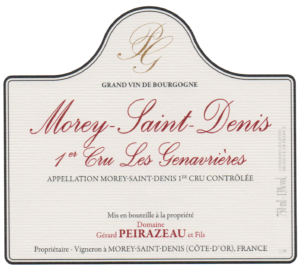
Morey-Saint-Denis 1er Cru Les Genavriéres
Vineyard Plot: Situated above Clos de la Roche and very close to Chambertin.
Grape Variety: Pinot Noir
Viticulture: The vineyard is cultivated using sustainable methods. Peirazeau uses organic products as much as possible and no pesticides. He shows respect for the subsoil with rigorous mechanical work by limiting passages in order to avoid compaction as much as possible.
Vinification: The harvest is entirely destemmed, to avoid excess tannins. In the cellar, Peirazeau has a minimal-intervention approach; he uses only indigenous yeasts and no added substances. The grapes are macerated in stainless steel tanks for 2-4 weeks with gentle manual pumping-over and punching-down for soft extraction.
Aging: In oak barrels (around 30% new oak on average) for about 18 months, no racking. Light filtration before bottling.
Tasting Notes: This Morey-Saint-Denis 1er Cru Les Genavrières evokes aromas of black cherry and cooked plum with spicy and lively touches. The palate is silky, tasty and lively. Its finish is powerful and elegant.

Chambolle-Musigny 1er Cru Les Hauts-Doix
Vineyard Plot: Situated between Les Charmes & Les Amoureuses.
Soil: Stony soil and a marl subsoil
Grape Variety: Pinot Noir
Average Age of the Vines: 70 years old for half of the vines, and 100 years old for the other half.
Viticulture: The vineyard is cultivated using sustainable methods. Peirazeau uses organic products as much as possible and no pesticides. He shows respect for the subsoil with rigorous mechanical work by limiting passages in order to avoid compaction as much as possible.
Vinification: The harvest is entirely destemmed, to avoid excess tannins. In the cellar, Peirazeau has a minimal-intervention approach; he uses only indigenous yeasts and no added substances. The grapes are macerated in stainless steel tanks for 2-4 weeks with gentle manual pumping-over and punching-down for soft extraction.
Aging: In oak barrels (around 30% new oak on average) for about 18 months, no racking. Light filtration before bottling.
Tasting Notes: The soil brings elegance and power controlled by a good roundness.
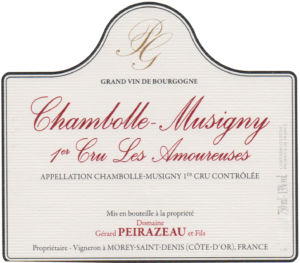
Chambolle-Musigny 1er Cru Les Amoureuses
Vineyard Plot: 0.21-hectare holding. Often considered as Grand Cru.
Grape Variety: Pinot Noir
Average Age of the Vines: Up to 80 years old.
Viticulture: The vineyard is cultivated using sustainable methods. Peirazeau uses organic products as much as possible and no pesticides. He shows respect for the subsoil with rigorous mechanical work by limiting passages in order to avoid compaction as much as possible.
Vinification: The harvest is entirely destemmed, to avoid excess tannins. In the cellar, Peirazeau has a minimal-intervention approach; he uses only indigenous yeasts and no added substances. The grapes are macerated in stainless steel tanks for 2-4 weeks with gentle manual pumping-over and punching-down for soft extraction.
Aging: In oak barrels (around 30% new oak on average) for about 18 months, no racking. Light filtration before bottling.
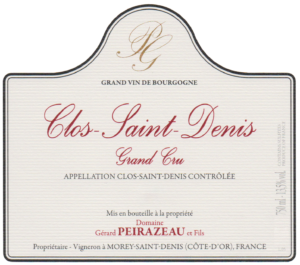
Clos Saint-Denis Grand Cru
Soil: Clay limestone and marl.
Grape Variety: Pinot Noir
Viticulture: The vineyard is cultivated using sustainable methods. Peirazeau uses organic products as much as possible and no pesticides. He shows respect for the subsoil with rigorous mechanical work by limiting passages in order to avoid compaction as much as possible.
Vinification: The harvest is entirely destemmed, to avoid excess tannins. In the cellar, Peirazeau has a minimal-intervention approach; he uses only indigenous yeasts and no added substances. The grapes are macerated in stainless steel tanks for 2-4 weeks with gentle manual pumping-over and punching-down for soft extraction.
Aging: In oak barrels (around 30% new oak on average) for about 18 months, no racking. Light filtration before bottling.
Tasting Notes: Voluptuous and gorgeous fragrance. This wine is open, elegant, and the height of sophistication.
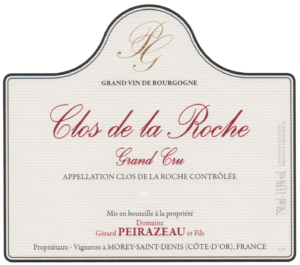
Clos de la Roche Grand Cru
Vineyard Plot: 0.40-hectare holding.
Grape Variety: Pinot Noir
Viticulture: The vineyard is cultivated using sustainable methods. Peirazeau uses organic products as much as possible and no pesticides. He shows respect for the subsoil with rigorous mechanical work by limiting passages in order to avoid compaction as much as possible.
Harvest: The vines are old, and the grapes are therefore millerandé. They are harvested very ripe while retaining their acidity, guaranteeing a high quality balance.
Vinification: The harvest is entirely destemmed, to avoid excess tannins. In the cellar, Peirazeau has a minimal-intervention approach; he uses only indigenous yeasts and no added substances. The grapes are macerated in stainless steel tanks for 2-4 weeks with gentle manual pumping-over and punching-down for soft extraction.
Aging: In oak barrels (around 30% new oak on average) for about 18 months, no racking. Light filtration before bottling.
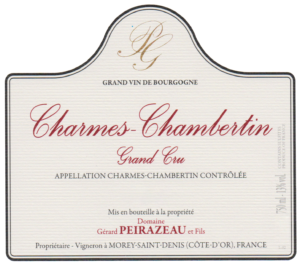
Charmes-Chambertin Grand Cru
Vineyard Plot: 0.22-hectare holding.
Soil: Limestone, with a subsoil that contains a layer of thick marl.
Grape Variety: Pinot Noir
Average Age of the Vines: Up to 80 years old.
Viticulture: The vineyard is cultivated using sustainable methods. Peirazeau uses organic products as much as possible and no pesticides. He shows respect for the subsoil with rigorous mechanical work by limiting passages in order to avoid compaction as much as possible.
Vinification: The harvest is entirely destemmed, to avoid excess tannins. In the cellar, Peirazeau has a minimal-intervention approach; he uses only indigenous yeasts and no added substances. The grapes are macerated in stainless steel tanks for 2-4 weeks with gentle manual pumping-over and punching-down for soft extraction.
Aging: In oak barrels (around 30% new oak on average) for about 18 months, no racking. Light filtration before bottling.
Tasting Notes: The soil is gives vigor to this wine which can be described as virile, but also a persistence of roundness.
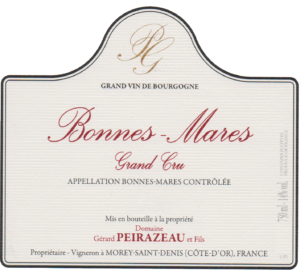
Bonnes Mares Grand Cru
Vineyard Plot: Bonnes-Mares straddles Morey-Saint-Denis and Chambolle-Musigny.
Grape Variety: Pinot Noir
Viticulture: The vineyard is cultivated using sustainable methods. Peirazeau uses organic products as much as possible and no pesticides. He shows respect for the subsoil with rigorous mechanical work by limiting passages in order to avoid compaction as much as possible.
Vinification: The harvest is entirely destemmed, to avoid excess tannins. In the cellar, Peirazeau has a minimal-intervention approach; he uses only indigenous yeasts and no added substances. The grapes are macerated in stainless steel tanks for 2-4 weeks with gentle manual pumping-over and punching-down for soft extraction.
Aging: In oak barrels (around 30% new oak on average) for about 18 months, no racking. Light filtration before bottling.
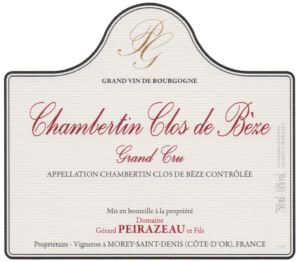
Chambertin-Clos de Bèze Grand Cru
Grape Variety: Pinot Noir
Average Age of the Vines: Up to 80 years old.
Viticulture: The vineyard is cultivated using sustainable methods. Peirazeau uses organic products as much as possible and no pesticides. He shows respect for the subsoil with rigorous mechanical work by limiting passages in order to avoid compaction as much as possible.
Vinification: The harvest is entirely destemmed, to avoid excess tannins. In the cellar, Peirazeau has a minimal-intervention approach; he uses only indigenous yeasts and no added substances. The grapes are macerated in stainless steel tanks for 2-4 weeks with gentle manual pumping-over and punching-down for soft extraction.
Aging: In oak barrels (around 30% new oak on average) for about 18 months, no racking. Light filtration before bottling.





